STANLEY KUBRICK'S Full Metal Jacket
Shot-by-Shot Analysis
Part Six
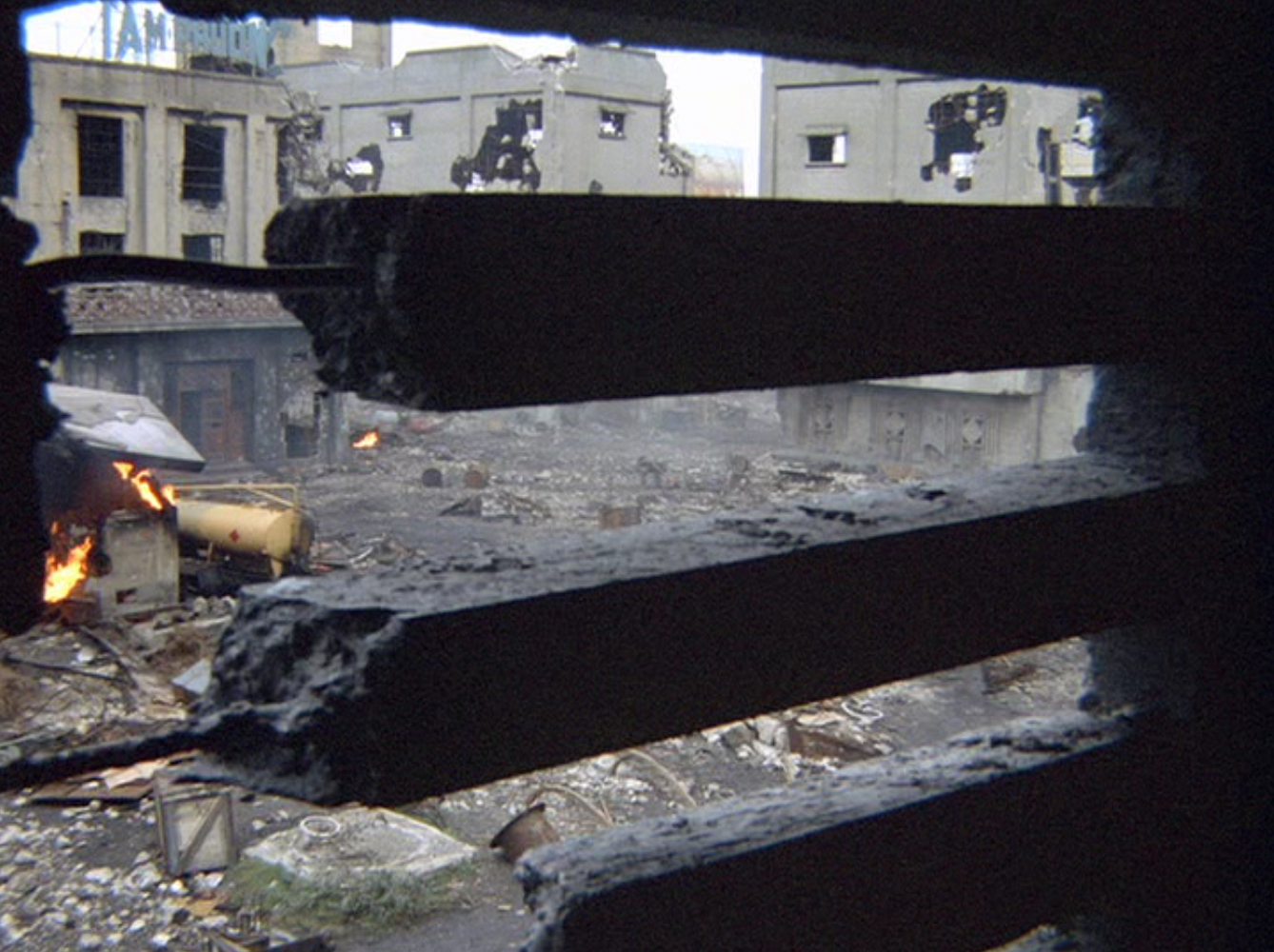
Go to TOC for this film ( (which has also a statement on purpose and manner of analysis and a disclaimer as to caveat emptor and my knowing anything authoritatively, which I do not, but I do try to not know earnestly, with some discretion, and considerable thought).
TOC and Supplemental Posts | Part 1 | Part 2 | Part 3 | Part 4 | Part 5 | Part 6 | Part 7 | Part 8 | Films Home
LINKS TO SECTIONS OF THE ANALYSIS ON THIS PAGE:
Intro to Part Six, Shots 445 through 454
The Rabbit Booby Trap, Shots 445 through 454
The Sniper Deaths of Eightball, Doc Jay, and Cowboy, Shots 455 through 546
Something I really wanted to do with this analysis of Full Metal Jacket was keep it as much as possible in the realm of Hasford's Vietnam, reminding of the book, and comparing to the experiences of others who went through boot camp and were then in Vietnam during the period of time covered in the book and film, showing as well how Hasford at times in a surreal poetic way has things occur which could not have, but the poetry relates a truth better than the reality, such as with the killing of Sergeant Gerheim/Hartman. And I wanted to account for some of the changes Kubrick made, and separate some of those made for practical reasons from changes made in service of Kubrick's vision. Among other things I had done in preparation for this:
There were more films I watched, I just don't recollect them all right now. And I read up on the Tet Offensive and the Battle of Hue, and dipped into the past several hundred years that led up to it all. My point being that I had put a lot of research into this so I could really look at the film as it related to Hasford's work and the Vietnam war experienced by many different Marines at boot camp and at Hue. I wasn't concerned about film representations being exact, but about in-the-spirit-of approximations.
Also, I supposed I could use this as just a personal opportunity to do an in-depth long-view on the war that was a daily presence in my youth.
Now, here we are in part 6 of the analysis. We are once again in this industrial area of Hue, a situation which didn't happen in the novel, which I have discussed earlier in the analysis, and we will find the Marines have taken a wrong turn in Kubrick's increasingly maze-like treatment of this area. I have shown how the Hue cinema takes us back to The Shining, when we are introduced to the maze, Jack examining it in the lobby, and Wendy out wandering it with Danny.
That Hue cinema, sitting in an industrial area with big concrete supports for pipes running up to it. We really do need to talk about that further, Kubrick's assumption that if it's approached in just the right way people are not going to question the outrageous. Fine, this was an industrial area. But a large cinema? I don't believe it's just "making do" with what you've got. One really needs to consider the surreal aspect of that movie palace, the jewel of Vietnam, sitting across from all those shipping containers, and what the hell it all means, because it's bozo. It's significant, structurally, that the "This is Vietnam--The Movie", and the physical body of the cinema, happen in the film when they do, an intermission in the war.
In, A Clockwork Orange, the Ludovico Treatment split the film into two parts, what came before Alex's brainwashing, and then what came after.
Enter CRM-114 with the Ludovico Treatment. Below is what I've written about it, in part, in my analysis on A Clockwork Orange:
Much is made of Kubrick's using CRM-114 or a version thereof somewhere in most of his films. In this one the CRM-114 is expressed in the Serum-114, this perhaps reinforced in the name of the drink the boys were specified as having at the beginning of the film, back at the bar, Drencrom, which is one of Burgess' Nadsat language terms and means "drug". The name of the Ludovico drug that Alex received wasn't referred to in Burgess' book, nor was it specified as a "serum". In no place in Burgess' book is a serum mentioned. The Drencrom (crom being drug) becomes our connection point between CRM-114 and the drug that is Serum-114.
ChRM, in Hebrew, means "chosen", as in secluded, devoted to religious purposes, especially destruction, and I think it's of importance here as the shot of the vial of Serum-114 occurs at the same time that Alex is being told he's quite lucky to have been chosen.
Again, in Dr. Strangelove the use of CRM is in conjunction with seclusion, meaning the lone, damaged jet which could not be contacted and turned back from delivering its bomb.
As the Kubrick fan knows, there's a history behind Kubrick and 114. Turning to Dr. Strangelove and Peter Bryant's book Red Alert:
"To ensure the enemy cannot plant false transmissions and fake orders, once the attack orders have been passed and acknowledged the CRM 114 is to be switched into the receiver circuit. The three code letters of the period are to be set on the alphabet dials of the CRM 114, which will then block any transmissions other than those preceded by the set letters from being fed into the receiver."Or, as it is put in Wikipedia:
The C.R.M. 114 Discriminator is a fictional piece of critical radio equipment...the destruction of which prevents the crew of a B-52 from hearing the recall code that would stop them from dropping their atomic bombs on the U.S.S.R.So, the CRM 114 was not an invention of Kubrick's. But he liked it. A lot. And it homophonically becomes here Serum 114.
The word "chosen" was used several times in Burgess' book but there was never this particular dialogue with Branom in which Alex was told he was lucky to be chosen, or that he was chosen at all, so it is Kubrick who has inserted this dialogue overlaying the vial of Serum-114.
ChRM-114 ties in directly with Alex's conditioning to make the suicidal leap from the window to his death, though an opposing political force negotiates it in the end. During the 2nd round of films Alex is shown, the Nazi films, he is presented footage of parachutists leaping from Nazi planes, the number on the most prominent plane being 0141, a permutation of 114.
141 is the gematria of MTzVH, meaning a commandment.
From Wikipedia:
It is a word used in Judaism to refer to the 613 commandments given in the Torah (at Har Sinai, Where all the Jews accepted the Torah, Saying "We will do, and we will listen") and the seven rabbinic commandments instituted later for a total of 620. According to the teachings of Judaism, all moral laws are, or are derived from, divine commandments.
The secondary meaning of Hebrew mitzvah, as with English "commandment," refers to a moral deed performed as a religious duty. As such, the term mitzvah has also come to express an act of human kindness. The tertiary meaning of mitzvah also refers to the fulfillment of a mitzvah.We will do, and we will listen. Alex will do, he will listen.
Having observed the parachutists leaping from the plane numbered 141, while listening to Beethoven, does Alex later, tormented by Beethoven, intuit his desire to snuff it and make his suicidal leap from the window.
See 114, Dr. Strangelove, and Lolita Collide in Scenic.
Does CRM or ChRM make an appearance in Full Metal Jacket?
In shot 411, Crazy Earl (General Custer in the "This is Vietnam: The Movie") says, in his interview, "Do I think America belongs in Vietnam? Um, I don't know. I belong in Vietnam, I'll tell you that." In the following shot, 412, Doc Jay is interviewed and we have our first frontal shot of the cinema, having previously glimpsed it from the side, when Crazy Earl makes his two kills, the rest of the NVA or Viet Cong escaping into the cinema itself...which we don't know yet is the cinema. Now we are in front of it, and Doc Jay says, "Can I quote LBJ? I will not send American boys eight or ten-thousand miles around the world to do a job that Asian boys ought to be doing for themselves."
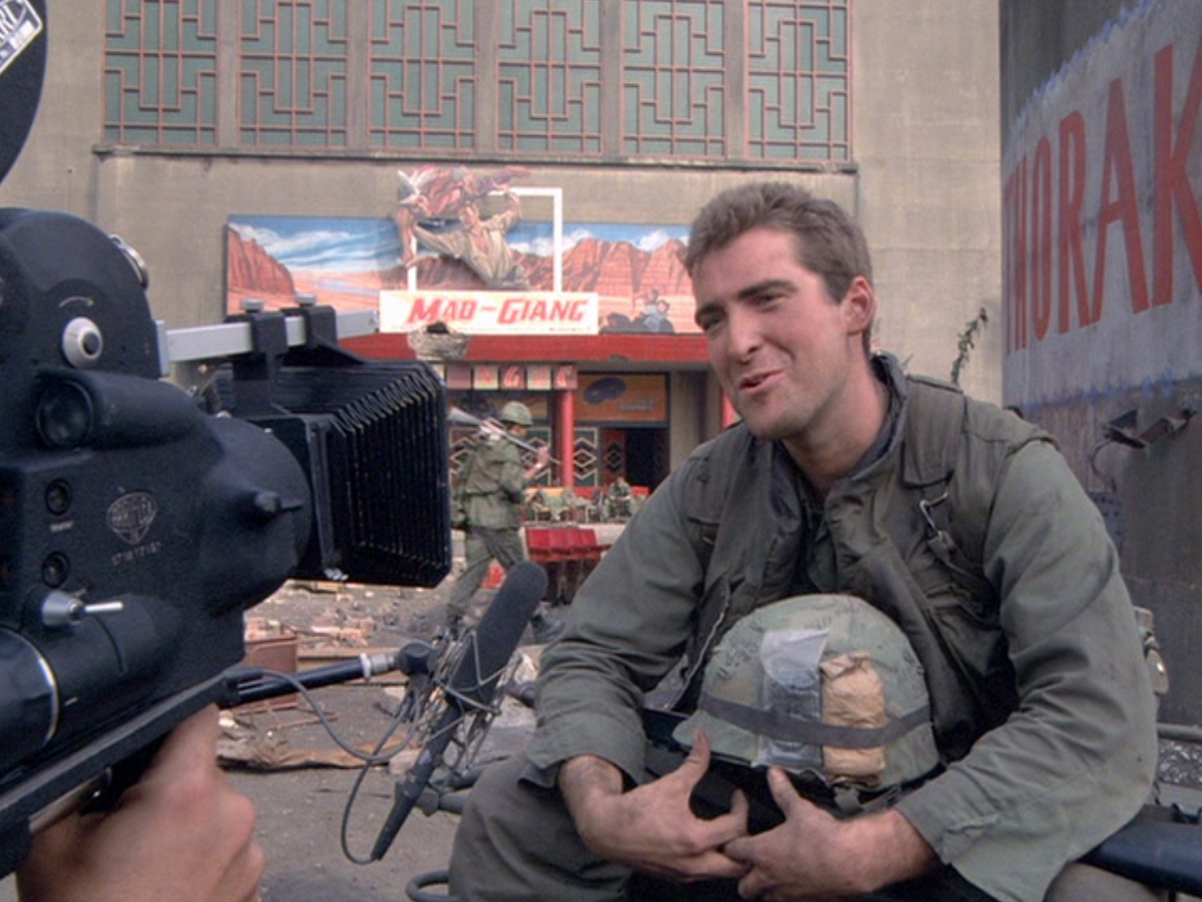
Following the interviews, the ARViN soldier rides up with the woman/girl who's going to be prostituted, and we see the view of the circular structure before the cinema from the front. Our first glimpse of the circular structure was in shot 412 when it was behind Doc Jay.
The CREME on the circular structure is the Full Metal Jacket version of CRM. Crazy Earl, who spoke in shot 411, will not survive. Doc Jay, in the shot the first time we see the circular structure on which we will view CRM, will not survive, the sniper takes him down. Eightball, who is the featured character in much of the cinema scene, is taken down by the sniper, the Marines isolated and without support.
In The Shining, a perplexity, as we are all well familiar with, is that the maze, sometime between our initial introduction to it, and the end of the film, turns so the entry to it is facing the hotel. Or another entry has opened. I take pains in my analysis of The Shining to show how Kubrick does have it turn, and that the turn happens while Jack is looking over the replica of the maze, Wendy and Danny at the heart of it.
The below extensive quote is from my analysis on The Shining--and I know it will all sound like BS, one will imagine we are simply looking at mistakes when we start talking about shadows and their orientations, but if we want to understand why/when the maze turned 90 degrees in its orientation to the lodge then this below is what we need to navigate:
We know from our morning view of the Overlook/Timberline exterior that the sun rises east/northeast of it, to the right. The sun was coming from the general direction of the west-northwest when Wendy and Danny entered the studio maze in the afternoon, and, though the maze's map gave the entrance as in the east, opposite where it should be located by the afternoon shadows, the heart of the maze was positioned roughly west-east and parallel the hotel. This places the set and live hotel in the same orientation to the sun.
Now, in this final shot of Danny and Wendy in the maze, we see faint shadows, and the sun seems to cast those shadows fitting with the sun being in the northwest. The maze's heart thus appears to run roughly perpendicular the lodge and so we would seem to see Wendy and Danny walking away from the lodge.
Though we have seen the opening to the outdoor maze being in the west (or east) and that its heart runs parallel the hotel, as soon as the world maze appears this has changed, and we see this change reflected in the shadows shown as Wendy and Danny walk the heart of the physical maze. The shadows coming from the W/NW, the heart of the maze now runs perpendicular to the hotel. The 90 degree shift of the maze has already occurred.
The shadows in the world maze can be assumed to be coming from the W/NW as well which means the camera is viewing the maze from opposite Jack, who stands in the west. The camera is viewing the maze from the position of the elderly man who had been looking at the maze on the day of Jack's interview. The same man who had appeared from around the corner when Jack stepped on the spot where he will later murder Dick.
......
Having seen these different versions of the maze, the one outside the lodge, the one on the table and in the map, and the world maze, we could compare this to the three perspectives we had of Jack's interview in Stuart's office, as determined by the way the objects were oriented, and, later, the three seeming perspectives of Room 237. Kubrick often seems to give three perspectives of a situation.
But it gets more complex.
When Danny and Jack enter the maze at the end of the film, the entrance is facing the lodge (which is in the north), rather than the entrance being in the west. It has shifted 90 degrees and I have already discussed how this shift has already occurred with the world maze.
But, it can't be quite so simple. We can't forget that according to the compass on the map, Danny and Wendy enter the maze from the east rather than the west. Kubrick quirks it up and then quirks it up some more so, according to the compass, we apparently have Danny and Wendy entering from the east which is impossible as the sun should be in the west. If we rely on the eastern orientation of the entrance, then Danny and Wendy entered the maze in the morning rather than in the afternoon, though Wendy served Jack breakfast near noon.
......
Why does Kubrick have the entrance to the maze both in the west and the east? Why does he shift the placement of the maze's map from north of the entrance to south of it?
On Closing Day, touring the grounds, the group had incomprehensibly passed the maze from its rear walking toward the hotel, what we would believe to be south to north (which counters the information given us on the maze map), but Ullman had introduced it to them as if they were just passing it for the first time. How likely is this? That he would lead them outside from the hotel, walk them past the maze to its rear, then only introduce it to them as they start back to the hotel?
The map of the maze was on the opposite side of the entrance from them as they approached. When they reached the parking lot, there was suddenly a 90 degree shift where instead of walking toward the hotel they were instead walking parallel it and were past where the entrance to the maze will be after its 90 degree shift. Then, in the Month Later section, when Wendy and Danny go to the maze, it is from the hotel, but the map has been moved to the other side of the entrance.
It is hard to envision but I'm going to posit that Kubrick has them moving as they do because they are moving between mirrored versions in a sense.
Is looking at all this too piddling a thing to do? Did Kubrick never intend us to take any of this into consideration? He must have, or he would not have reoriented the maze's entrance to be facing the hotel at the end of the film.
On Closing Day, how did Dick begin to show Wendy into the C4 freezer but they instead enter the C3 meat locker opposite? It's for the same reason that Kubrick shows the group being introduced to the maze as they walk past it toward the hotel.
We are working with oppositional/reversed perspectives, such as seen here with the maze, such as with one drive to the hotel being east to west, the other being west to east (only one approach is possible), and both ending before or around the area of the Continental Divide.
We are also working with 90 degree shifts. We have both, over and over, and in conjunction with each other. And Kubrick makes this plain to us with the physical maze and what we know about it as opposed to the map of the maze which has a completely opposite orientation.
Have I lost you? Or maybe you decided to not think about it too much and just kind of wisely skip over the above section? Pain's the brain, doesn't it, having opposing realities sandwiched together in this manner. But if you're in tune with what Kubrick is doing you can, Closing Day, walk with the group from the south to the north of the maze, from its rear toward the hotel, and you can feel the world maze propogating about one, composed of oppositions and turns.
After this, the maze's entrance isn't shown until the end of the film. But it has already shifted, after Jack lost his ball, which is when we get a major shift in Jack's attitude.
Anyway, that's the big thing to know. The maze entrance shifts about 90 degrees between today and the end of the film, and apparently shifts today. There's a bit of muddle tugging here and there at the corners, but I'm just keeping my eye on the 90 degree shift that puts its heart perpendicular the hotel, which appears to have happened with the world map.
This is important now. Because this film is Kubrick's, not Hasford's, and this is not just about Vietnam. All my research on Vietnam and the experiences of veterans doesn't come into play after a certain point, and we're past the point reached in the film where it is solely Kubrick's world and Kubrick will be Kubrick in every single film of his.
There is no wrong direction taken in Hasford's book. Just as Pyle's equivalent experiences no left/right disorientation in Hasford's book, there was also no wrong direction taken by Cowboy and his squad in Khe Sanh. But left/right error was in The D.I., and Tribes, for purely practical reasons, and I have shown how Hasford draws from both those sources, Kubrick has as well, and now via Kubrick the left/right confusion melds with Hasford. Because Kubrick always has left/right flips, horizontal reversals, so they are a feature in Full Metal Jacket. We already observed a version of this in shots 53 and 54 when the recruits are out jogging in boot camp and, as with the maze in The Shining, the shadows switch so in shot 53 the shadows stretch long to the rear of the recruits whereas in shot 54 they stretch long to the front. I pointed out in Part One how the subsequent shot 55, in which recruits are climbing ropes with the bright red sky and sun behind them, refers back to 2001 and the appearance of the monolith, all of this immediately followed by Pyle being bullied and slapped right and left in shots 56 through 60 for not knowing his left from his right.
As for why shot 55 is a monolith shot, I have already explained this in Part One, with visuals but I'll describe it briefly again here. In shot 5, in 2001, the sun rises in a blood red sky over Africa. The front projection landscape for this, identified by the two hills and the position of the clouds never changing, is used several times in the hominid section, and always with the same orientation, except once. In shot 55, the same landscape is used when the monolith appears and the dawn landscape has been flipped horizontally. Then in shot 56, it flips again back to its original orientation. There was a mirroring, essentially, with the appearance of the monolith. At the end of the film, it is in shot 595, as the camera, and Dave, enter the monolith positioned before his bed, that we get a perfect symmetry shot, left and right mirrored exactly, the black void of the "between" of the monolith separating them. Kubrick's world takes us from 5, to 55 with the reversal of the landscape behind the first appearance of the monolith, to our finally entering the labyrinth in shot 595 where we experience perfect symmetry of the mirrored sides. Add 9 to any number and it disappears. 5 and 9 is 14 becomes 5. 122 and 9 becomes 5 and 9 becomes 14 becomes 5. Shot 595 is commentary on and instructs how we are to interpret the reversal of the landscape when the monolith first appears in shot 55. Having already been reborn as the Star Child, Dave passes through the monolith in shot 595. Shot 55 in Full Metal Jacket is followed by Pyle being bullied for not knowing his left from his right (everyone else places their rifles on their left shoulders, he on his right, and next we see he is being treated like an infant, made to suck his thumb while he marches like a toddler, shuffling with his pants around his ankles. This infantilization isn't to compare with Dave being reborn but it does connect. Actually, all the men are being "reborn" as Marines.
Having discussed the above, I'm going to leap ahead to the film's end. You know how I've described how Dave Bowman and the camera enter the monolith in shot 595 in 2001 and we are consumed by blackness. When I began counting down the shots in Full Metal Jacket and hit shot 55, and considered the tie-in to shot 55 in 2001, I suspected that when I finished the count of the shots that if we hit 595 that it would also similarly tie-in to 2001. I found that the last shot, the Marines marching to the Perfume River, is shot 594, in which we view two columns in the fiery, smoky background that resemble monoliths, but aren't exactly. Then black, just as Dave and the camera enter into, in shot 595, the black of the between that is the monolith, while in shot 595 in Full Metal Jacket (f we can go ahead and call it a shot, though the cinematic portion has ended and we're moving into credits) the Rolling Stones begin to sing "Paint it Black".
In A Clockwork Orange, it's in shot 594 that Alex makes his suicide leap, and in shot 595 we have the camera giving his POV as he hurtles toward the pavement below and all goes black. Just as we have the camera giving Dave's POV as he enters the monolith in shot 595. What happens when Alex wakes up after his death plunge? It is to the sound of a doctor and nurse having sex, and in a voice-over he says that he "came back to life after a long black black gap of white might have been a million years." Alex reborn.
In shot 55 in A Clockwork Orange we have Alexander's wife entering the hall to the front door in which there is the checkerboard black-and-white pavement and mirrors from floor to ceiling stretching the length of the hall on either side, mirroring all that happens as Alex gains entry by deception, then brutalizes the couple. Shot 55 in The Shining is when Danny stands before his mirror in the bathroom, speaking with Tony in it, and begs Tony to show him why he doesn't want to go to the hotel. Zoom in on Danny's eyes in the mirror and cut to the vision of the elevators in the Overlook's hall, a flood of blood forcing through the doors, and the two girls appearing.
There is only one mirror shot in Full Metal Jacket, when Cowboy is shaving and reunites with Joker, who calls Cowboy the Lone Ranger, the only time Cowboy is called this in the film, but it thus connects with the Lone Ranger film showing as a second feature at the cinema.
445 Black. Sounds of gunfire. Fade in to the Marines traversing a bombed-out urban landscape. (1:25:56)
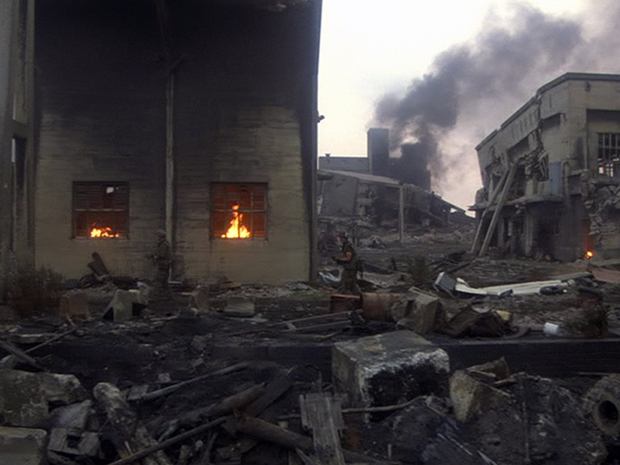
446 MS of Joker walking screen left to right. (1:26:25)
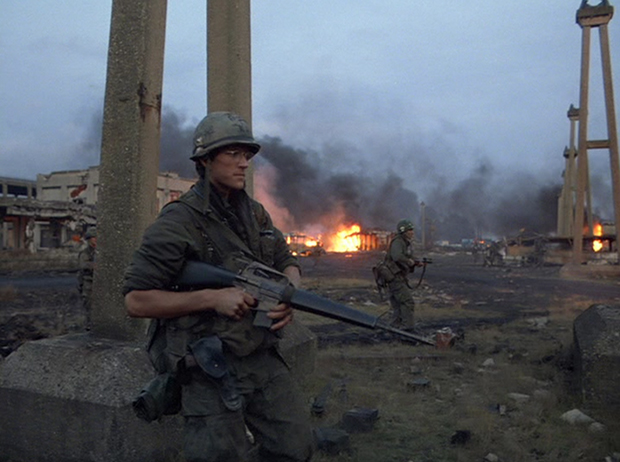
JOKER: Intelligence passed the word down that during the night the NVA...
447 Crossfade to circular structure with Shell sign on it. (1:26:31)

JOKER: ...had pulled out of our area to positions across the Perfume River. Our squad is sent on patrol to check out the report.
448 Crazy Earl walking screen right to screen left. He passes upset baskets. Enters a building. (1:26:39)
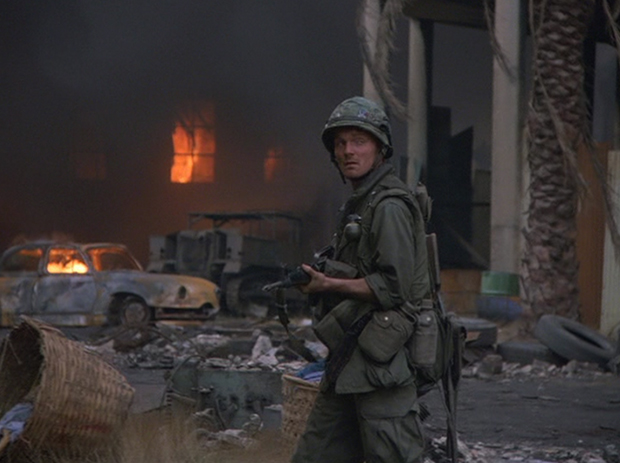
449 LS showing the interior of the room Crazy Earl has entered. Exiting, he sees a large bunny toy lying on the ground, with a black top hat and bow tie, and red jacket. He bends to pick it up. The bunny is rigged and he's felled by a bomb that goes off behind him. (1:26:52)
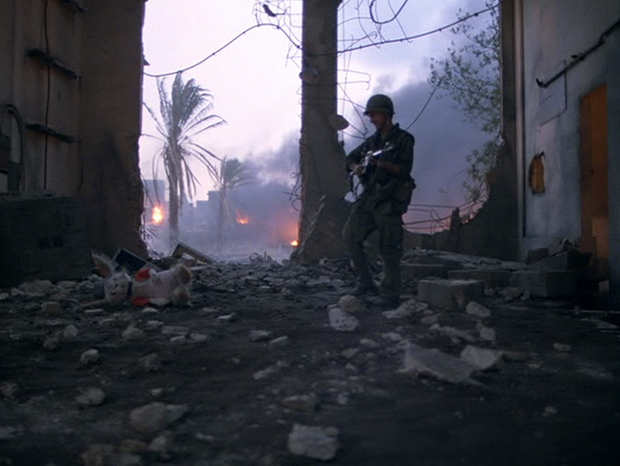
450 The other Marines throw themselves to the ground. (1:27:08)
451 CU Cowboy on the ground. (1:27:12)
COWBOY: Face outboard and take cover. Do it.
452 Marines place themselves with weapons facing the camera. Others run to the rear. (1:27:12)
453 Doc Jay passes through the building through which Crazy Earl had passed before being felled. He works on Crazy Earl. (1:27:19)
454 Cowboy approaches from the left. (1:27:32)
DOC JAY:
He ain't gonna make it. (Pumps Crazy Earl's chest after giving mouth-to-mouth.)
COWBOY:
Shit.
Joker enters from the right as Cowboy radios.
COWBOY:
Hotel One Actual, this is Cowboy. Hotel One Actual, this is Cowboy.
MAN [ON RADIO]: Hotel One. Over.
COWBOY: Murph, this is Cowboy. Crazy's hit. Booby trap.
MURPHY:
Wait, One. Okay. You're senior NCO, Cowboy. You're in charge. Continue with the patrol .and call in at the next checkpoint.
COWBOY: Roger.
Roger. Out. (Nervous.)
I'm squad leader.
JOKER:
Follow you anywhere, scumbag.
All right.
DOC JAY:
He's dead.
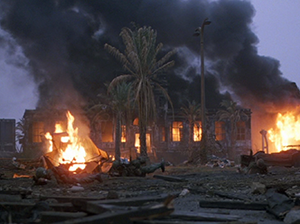 450 |
 451 |
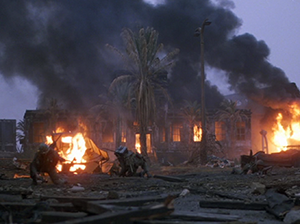 452 |
 453 |
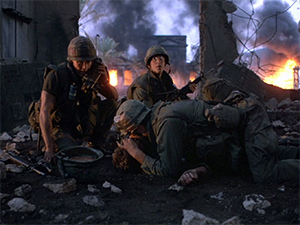 454 |
|
The rabbit toy that Crazy Earl stoops to pick up, which is booby trapped, wears a top hat, and might remind of the trick in which a rabbit is pulled out of a magician's top hat. Hartman had associated the magic show with religion, and there is a section in the book which associates it not only with religion but a chaplain killed by a booby trap.
In your dream you call for Chaplain Charlie. You met the Navy chaplain when you interviewed him for a feature article you were writing. Chaplain Charlie was an amateur magician. With his magic, Chaplain Charlie entertained Marines in sick bays and distributed spiritual tourniquets to men who were still alive, but weaponless. To brutal, godless children Chaplain Charlie spoke about how God is merciful, despite appearances, about how the Ten Commandments lack detail because when you're writing on stone tablets with lightning bolts you're got to be brief, about how the Free World will conquer Communism with aid of God and a few Marines, and about free fish. One day a Vietnamese child booby-trapped Chaplain Charlie's black bag of tricks. Chaplain Charlie reached in and pulled out a bright ball of death...
Crazy Earl dies, killed by his curiosity, stooping to pick up what is obviously out of place. We have just been shown how the are has been reduced to rubble. The magic rabbit didn't belong.
One pill makes you larger
And one pill makes you small
And the ones that mother gives you
Don't do anything at all
Go ask Alice
When she's ten feet tall
And if you go chasing rabbits
And you know you're going to fall
Tell 'em a hookah-smoking caterpillar
Has given you the call
Call Alice
When she was just small
When the men on the chessboard
Get up and tell you where to go
And you've just had some kind of mushroom
And your mind is moving low
Go ask Alice
I think she'll know
When logic and proportion
Have fallen sloppy dead
And the White Knight is talking backwards
And the Red Queen's off with her head
Remember what the dormouse said
Feed your head
Feed your head
Source: Jefferson Airplane
Moving the plot forward, the death of Crazy Earl elevates Cowboy into the position of squad leader.
In Barry Lyndon, we have an appearance of a rabbit during a magic show for Bryan, the magician having brought him up on stage where he performs before a Zodiac backdrop. The magician, having already produced a flower in the colors of the rainbow, tells Bryan that all the colors of the rainbow produce one color, white. He shows Bryan how there is nothing in his magic cabinet, opening its drawer for him. Then he closes the drawer, opens it again, and now there is a "beautiful white rabbit." Later, in a scene in which Bullingdon and seated at their desks, studying, Bryan pesters him with questions. He inquires what a quadrangle is, and is told it's a shape with four sides, like a square orr rectangle. In the next shot, 591, Bryan, looking for something, raises a book on which a black slate (in effect, a little monolith) is set, and it falls to the floor. Bullingdon becomes enraged at the noise, and Bryan pleads he's looking for his pencil. In shot 595 he opens the drawer of his desk to see if the pencil is there, but it isn't. At this point we should remember the "nothing" in the magician's drawer/cabinet, and that after the magician's instruction on all the colors of the rainbow producing white, he reveals a white rabbit in the drawer. Not finding his pencil, Bryan grabs Bullingdon's pencil, saying that's his pencil and not Bullingdon's. Bullingdon spanks him and consequently Bullingdon is spanked by Barry. Bullingdon vows if Barry lays hands on him again he will kill him. This is followed by the play within the film in which Bullingdon demonstrates at his mother's recital, having put Bryan in his shoes, that Barry is attempting to replace him with Bryan. But, as he points out, he's not dead yet and so Bryan doesn't have a title. We will have something akin here with Cowboy taking Crazy Earl's place when he dies after the white rabbit exploding on him, but Animal Mother doesn't take Cowboy's orders, which ultimately causes Cowboy to be killed.
So many of the Vietnam War movies have had the jungle serving for the war stage that anything other seems strange. Hasford and Kubrick have taken us into Hue, and in the 1980s this was an alien perspective. I've already discussed in Part Four how we are being moved further away from the "World", though Hue is a major city. Kubrick has chosen to show the soldiers as relatively isolated, as they move through the urban terrain. We aren't in residential areas and we see no civilians who have opted to remain behind rather than flee. We see no civilian corpses. We don't see much in the way of the litter of abandoned belongings. The only ARVN with whom the Marines have contact will be the pimp who was at the cinema. Sometimes it can seem that this is a film about Americans at war less with a people than a map of which they are taking possession.
I had once postulated that, after Fear and Desire, another war film, Kubrick never filmed again in a forest as creating Kubrickian-style visual interest was difficult in a natural environment. As close as he comes to it is in the wreckage of Hue in Full Metal Jacket where, despite considerable differences in every frame, there is a monotonous sameness to the destruction, the fires, the smoke, the blasted and burned out hulls of concrete buildings that almost universally, on the interior, give away no indication of what had been their purpose, the exception thus far having been the theater. There are cars, other vehicles, a lot of tires, metal barrels, and the occasional basket, often empty, but all of this is impersonal. The lack of personality, except for the few ads, means we see no machinery, no furnishings except for a few smashed chairs, no cabinetry, no pictures or posters left on the walls. We don't see papers blowing about, file cabinets, desks, counters, machinery in production facilities or the effects of the record-keeping side of business. The dearth of personal effects makes the rabbit toy especially conspicuous.
How the death of Crazy Earl is filmed dissociates him to some degree from what we've observed. We are shown the circular structure with the Shell oil sign, which reads something along the line of, "We continue to serve you, sir", and two Marines before it, one of whom is not Crazy Earl. So, we do have this landscape that will prove to be our location, but Earl isn't shown in the establishing shot.
We are then shown Crazy Earl in a medium shot in shot 448. We can see beyond him a burned out white car. This car can actually be observed just to the screen left of and beyond the Shell Oil structure in shot 447, but the way shot 448 is framed we aren't given that context and we can't really fix him in the landscape of the Shell Oil structure. In shot 447, Kubrick hadn't shown us any buildings before and to the screen left of the structure, and Earl is about to enter such a building.
Still in shot 448, Crazy Earl enters a building.
With shot 449, Kubrick drops back to show Crazy Earl framed by the building as if it is a stage--it is an exceptional shot, the only one of its kind in the film--and, as audience, we are removed from the stage by heaps of rubble, which also help create the sense of a stage, along with the way in which Earl is lit by the fire, from below, in the manner of stagelights. As usual, there is nothing in the bulding that gives us a clue as to what may have been its purpose. There is no personality that distinguishes it from the other structures. There are, however, empty cubbies. We have observed nothing like this before, and they stand out. I have described how in Barry Lyndon the magician entertains Bryan on the stage and has him look in an empty drawer before producing from it a white rabbit. In Full Metal Jacket, following the appearance of the empty cubbies, Earl finds the rabbi.
Crazy Earl passes out of the building into what appears to be the outdoors. We glimpse through the window of the building the Shell logo on the structure observed in shot 447.
Oh, look, on screen left there is a street lamp, in which one could perhaps read the idea of mirroring but is it intentional or happenstance? However, if you think about it, where else in the Hue scenes do you see a streetlamp? I do believe this is the only one. The street lamps we see at Paris Island and at the Marines base are single bulb rather than double.
We realize that Crazy Earl is still "indoors", but there is no fire here and the area is illuminated by natural light. In the midst of the blasted rubble is the rabbit which he bends down to pick up, triggering the booby trap. We are far enough to the left of the Shell Oil structure that, speaking of doubling, the Shell Oil logo is a second one that we are seeing, which was out of sight in shot 447, positioned around the screen left of the structure. This can also slightly confuse our bearings.
A shell ia a "husk" but has another meaning, to bomb.
When Touchdown had been killed, Murphy had gotten on the tank's radio and called Delta Actual Six. We then had been shown Crazy Earl crossing over from the first tank to the second tank (which hadn't previously been there) to inform the Marines that they would be moving up the roads to check out what was there. Here, Cowboy calls Murphy at Hotel One Actual and receives the news he is senior NCO and that he's to continue on and call in at the next checkpoint.
455 Animal Mother passes a burning building. (1:28:50)
456 Crossfade to Cowboy walking left to right. The camera passes behind a column that completely blacks out the screen momentarily. Cowboy gazes over at the camera. (1:29:03)
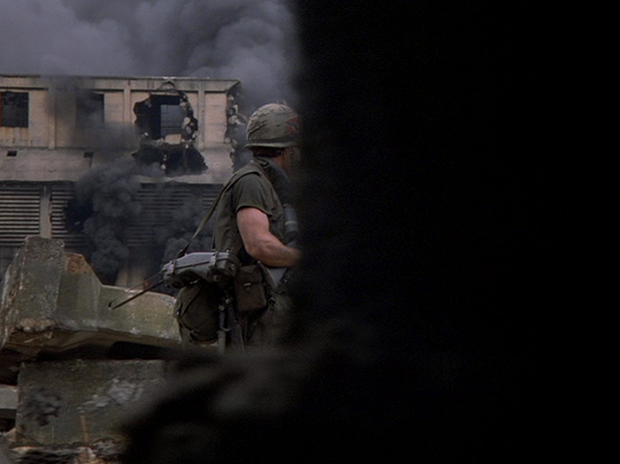
457 View of buildings with a VAN HUE sign over a blue facade. Eightball raises his hand and turns to the rest of the Marines. (1:29:14)
458 Eightball from behind as he faces the rest of the Marines. They are beside a one story structure upon which are numerous ads. He motions everyone to lower themselves to the ground. (1:29:24)
EIGHTBALL (quietly calls to Cowboy): Cowboy!
Cowboy follows him to a low wall against which they sit, Eightball examining a map.
459 MCU of Cowboy and Eightball against the wall. (1:29:38)
COWBOY: What's up?
EIGHTBALL: I think we made a mistake at the last Checkpoint. Here, see what you think. I think we're here, and we should be here.
COWBOY: We're here?
EIGHTBALL: Yeah.
COWBOY: We should be here?
EIGHTBALL: Yeah, that's right.
460 MCU of Animal Mother, Rafter Man in the background. (1:30:01)
461 Cowboy and Eightball as in 459. (1:30:03)
COWBOY: Fuck. What do you think?
EIGHTBALL: I think we should change direction. (Pointing over the wall.)
Cowboy gazes over the wall with binoculars.
462 MCU of Joker. (1:30:27)
463 Cowboy and Eightball at the wall as in shot 461 (1:30:27)
COWBOY: Okay. We'll change direction. (He waves over the men.)
464 Animal Mother and Rafter Man as in shot 460 rise and approach, the others following. (1:30:41)
465 MCU Side view of Eightball and Cowboy, Joker running up, the others following. (1:30:47)
JOKER: What's up?
COWBOY: Change in direction.
JOKER: What are we, lost?
COWBOY: Joker, shut the fuck up. Okay, listen up. Can you hear me?
MARINES: Yeah.
JOKER:
Okay, we're changing direction. We're heading over that way. Eightball's gonna go over there and see can he find a way through. Got it?
MARINES: Got it.
COWBOY:
Eightball, let's dance.
EIGHTBALL: Put a nigger behind the trigger.
466 MCU Rear view of Joker, Cowboy and Eightball. Eightball steps over the wall and crosses the open area to the far buildings. (1:31:22)
467 MCU Doc Jay from the right. (1:31:37)
468 MCU to the rear of Cowboy as Eightball, in the distance, enters an alley between buildings. (1:31:41)
 455 |
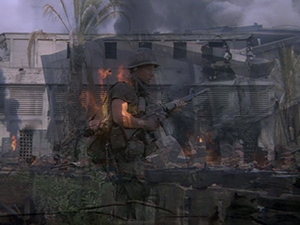 456 |
 457 |
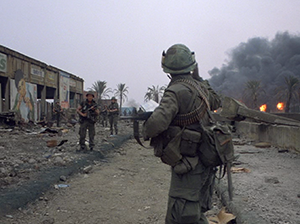 458 |
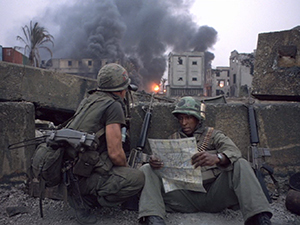 459 |
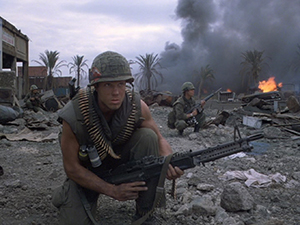 460 |
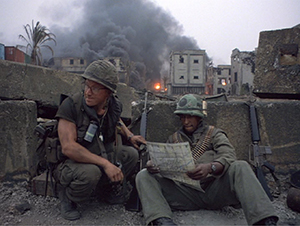 461 |
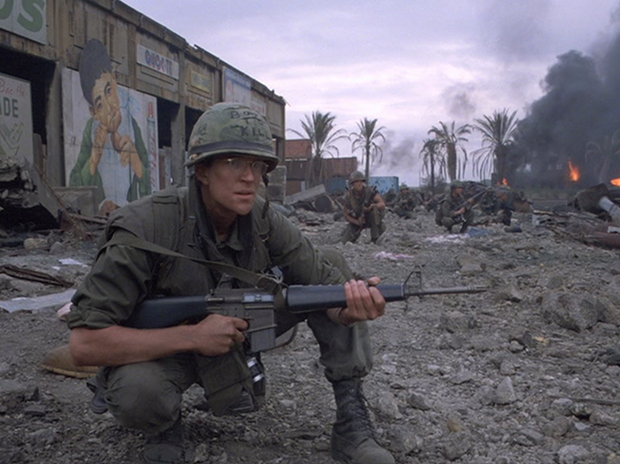 462 |
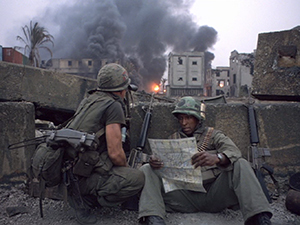 463 |
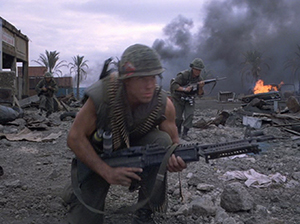 464 |
 465 |
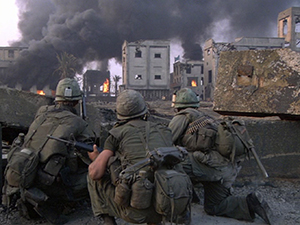 466 |
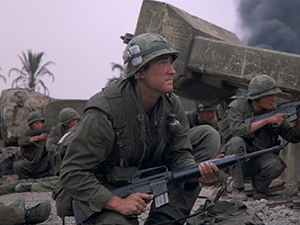 467 |
 468 |
469 Sniper's POV looking down to Eightball. Standing in the open, he turns screenright and waves for all to follow. Gunshot. (1:31:48)
470 MS of Eightball as he's shot in the leg. He screams. We see the sniper would be in the MY-TOAN building beyond. (1:32:11)
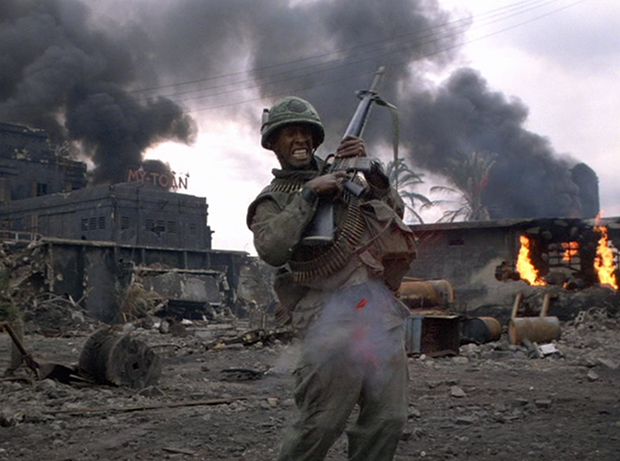
471 The Marines fire towards the buildings. (1:32:14)
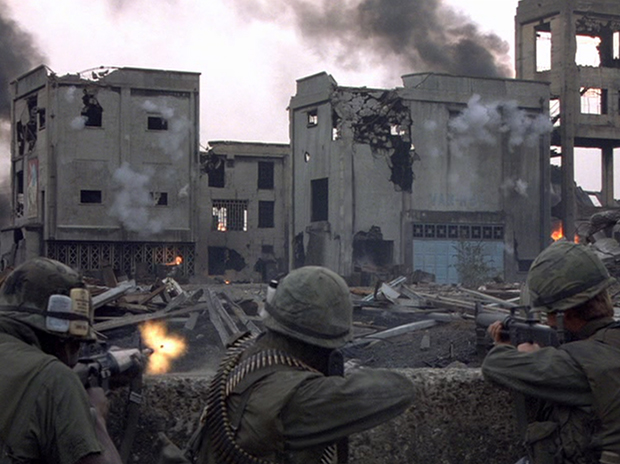
472 MS of Eightball twisting and falling, slowmotion. (1:32:18)
473 MCU from right of Doc Jay firing. (1:32:19)
474 Continued slow motion of Eightball falling to the ground. (1:32:21)
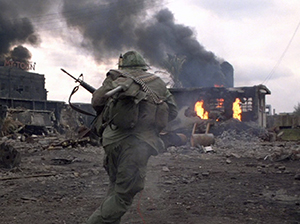 472 |
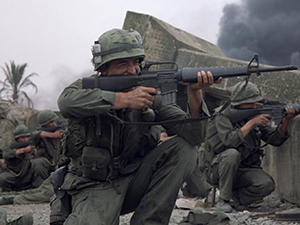 473 |
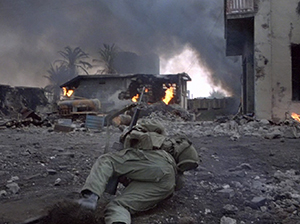 474 | |
475 CU of Animal Mother firing. (1:32:23)
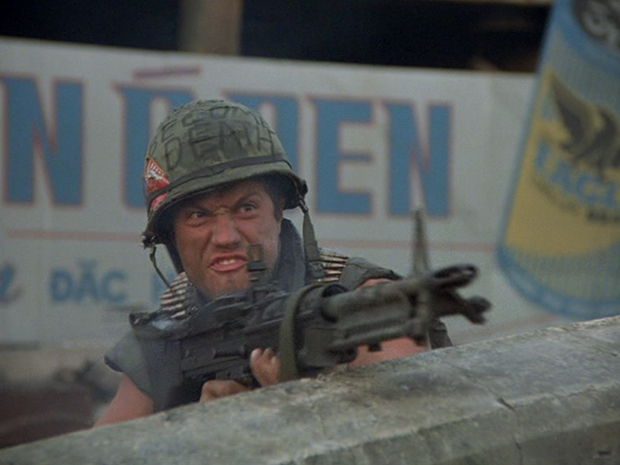
476 View from behind Animal Mother of him firing. He appears to be the one shooting out windows in the building with the blue facade. (1:32:25)
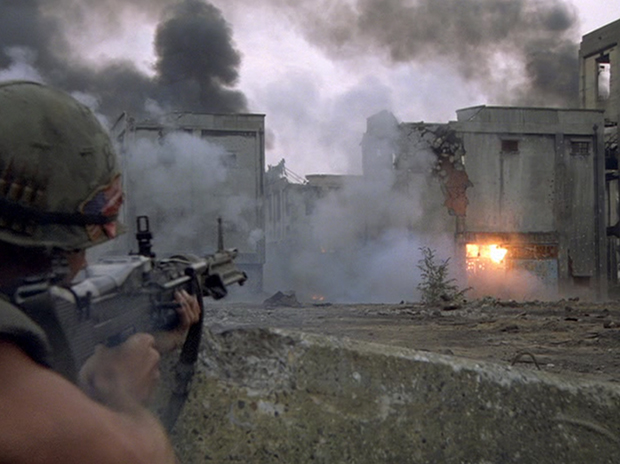
477 The building being blasted. (1:32:29)
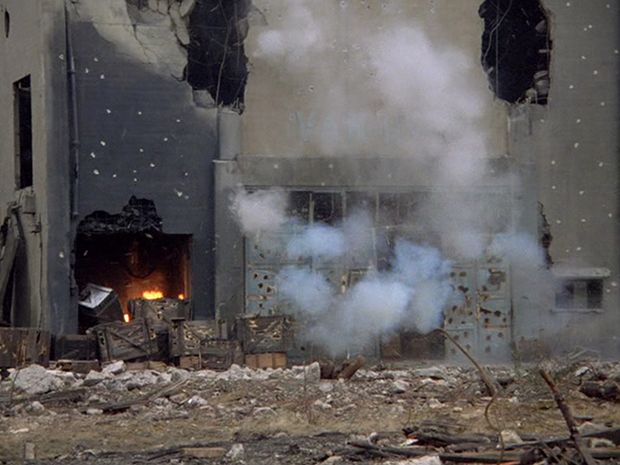
478 CU of T.H.E. Rock firing a mortar. (1:32:32)
479 View from being Marines firing on the area. (1:32:33)
480 CU of a mortar being fired. (1:32:38)
481 View as in shot 479. (1:32:39)
482 MCU of Cowboy from the right, Joker beyond. (1:32:41)
COWBOY: Ceasefire, goddamn it. Cool it, goddamn it. Cool it. Ceasefire. Hold it. Cease fire.
Various Marines call out to cease fire.
COWBOY:
Okay, listen up. Did anybody see a sniper? Did anybody see anything?
Marines call out to each other did anyone see a sniper.
COWBOY:
Okay, then save your ammo. Nobody fire till I tell you.
483 MCU of Eightball in slow motion being shot through the arm. (1:33:03)
484 Shot as in 482, Animal Mother beyond Joker. (1:33:06)
ANIMAL MOTHER (firing again): Eightball!
COWBOY: No, no. Cease fire. Ceasefire. Animal, cease fire.
DONLON (approaches Cowboy with the radio): Cowboy, it's Sergeant Murphy.
COWBOY: This is Cowboy. Over.
MURPHY (off screen): This is Murphy. What is your present position? Over.
COWBOY: Murph, we're receiving enemy sniper fire. Eightball is down. Our position is about half a klick north of Checkpoint Four. Believe possible, strong enemy forces occupying buildings in front of us. Request immediate tank support. Over.
MURPHY (off screen): Roger. Understand. I'll see what I can do. Over.
COWBOY: Roger. Over and out. (To Donlon.) Stay close.
DONLON: Got it.
COWBOY:
Okay, listen up. I think we're being set up for an ambush. I think there may be strong enemy forces in those buildings over there. I've requested tank support. We're gonna sit tight till it comes, but keep your eyes open. If they decide to hit us, we'll have to...
485 Eightball, slow motion, rolling over, he is blasted through the foot. (1:34:02)
COWBOY: ...pull back fast.
486 Shot as in 484, Animal Mother firing again. (1:33:06)
COWBOY:
Goddamn it. Halt. Cease your fire, Mother. Cease your fucking fire.
Doc Jay: Cowboy.
COWBOY: What?
Doc Jay: We can't leave him out there.
COWBOY: We're not leaving him, we'll get him when the tank comes up.
487 MCU of Doc Jay. (1:34:16)
DOC JAY: He's hit three fucking times. He can't wait that long.
488 Shot as in 486. (1:34:20)
COWBOY: I seen this before. That sniper's just trying to suck us in, one at...
489 Eightball is struck again through his other leg. (1:34:25)
COWBOY: ... a time.
490 Shot as in 488 as Animal Mother starts firing again. (1:34:28)
COWBOY: Goddamn it. No. Goddamn it, cease fire. Cease fire.
DOC JAY: Man, fuck it, fuck this shit. I'm going in to bring him out.
COWBOY: No, you sit the fuck down!
DOC JAY (going over the wall): Cover me.
COWBOY (starts firing along with everyone else): Goddamn it!
491 From behind Animal Mother as Doc Jay runs across the open area to Eightball. (1:34:44)
492 CU of Animal Mother firing. (1:34:50)
493 LS of Doc Jay running into the complex of buildings. (1:34:53)
494 Cowboy, Joker and others from the right as in shot 490. (1:34:58)
COWBOY: Cease fire! He's there! Cease fire! He's there! (Looks through the binoculars.)
MARINE: Cease fire!
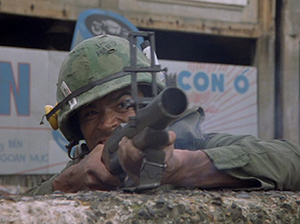 478 |
 479 |
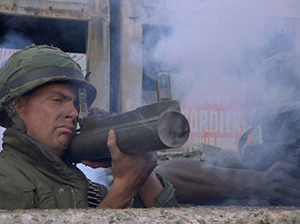 480 |
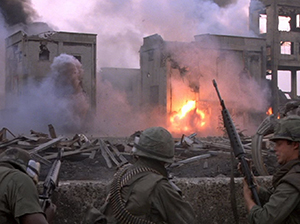 481 |
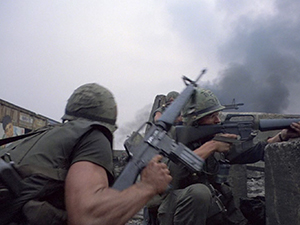 482 |
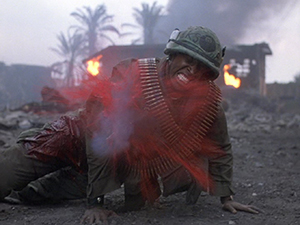 483 |
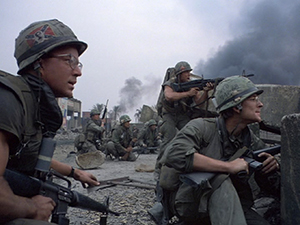 484 |
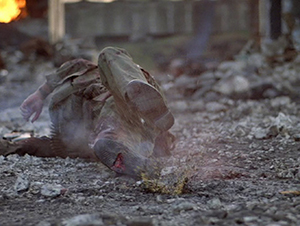 485 |
 486 |
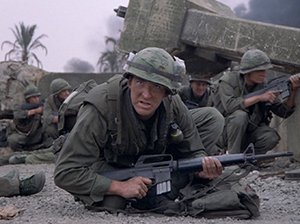 487 |
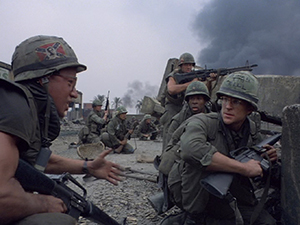 488 |
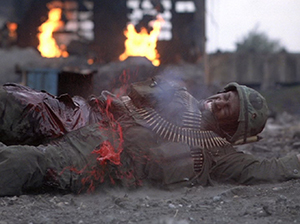 489 |
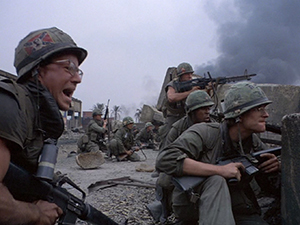 490 |
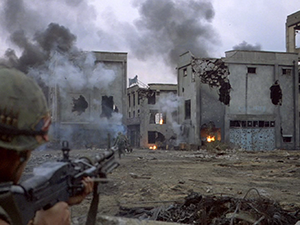 491 |
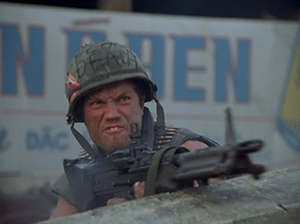 492 |
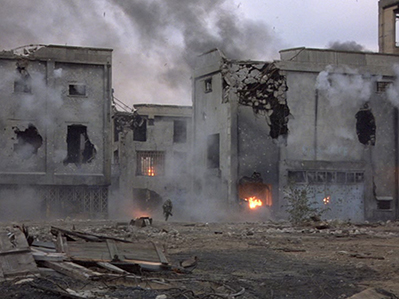 493 |
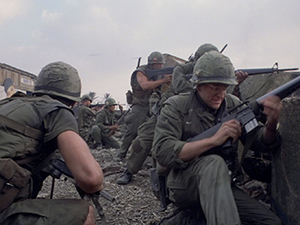 494 |
|
495 POV of the sniper as Doc Jay tries to pull Eightball to safety. Zoom in. They shoot. (1:35:08)
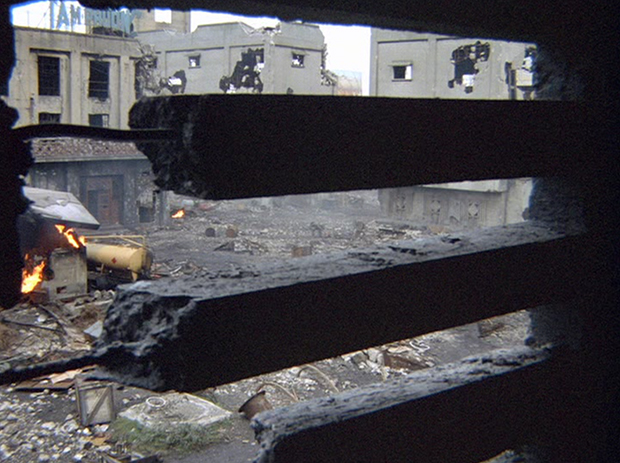
496 MCU of Doc Jay from his left as he's blasted through the chest in slow motion and falls. (1:35:14)
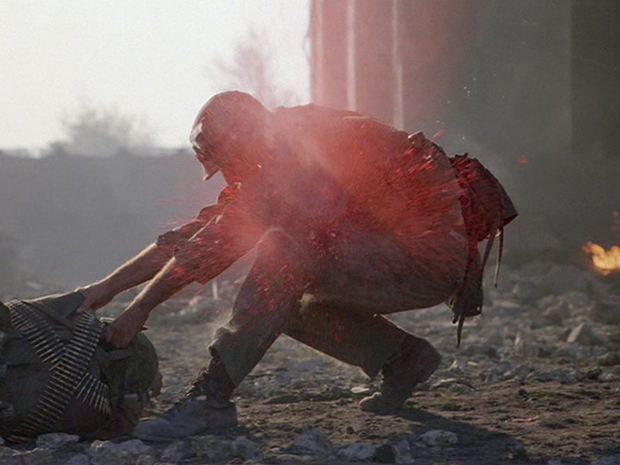
497 View of Cowboy, Joker and others from the right as in shot 494. Cowboy surveys the scene with binoculars. (1:35:19)
COWBOY: Hold your fire. Hold your fire. Cease fire, you can't see the sniper. Save the ammo. Nobody fire till I tell you. Nobody. (Looks back out with the binoculars.)
498 MCU of Doc Jay writhing on ground next to Eightball. (1:35:31)
499 Side view of Cowboy, Joker and others as in shot 497. (1:35:36)
COWBOY:
Hold your fire.
ANIMAL MOTHER:
What the fuck do we do now, Cowboy?
COWBOY (to Donlon): Give me that fucking radio. Murph? This is Cowboy. Over.
MURPHY (off screen): This is Murphy. Over.
COWBOY: Murph, we're in some deep shit. I got two men down. What's the story on that fucking tank? Over.
MURPHY (off screen):
Sorry, Cowboy. No luck so far with the tank. Will advise. Over.
COWBOY:
Roger. Out.
DONLON: Numb-nut bastards.
COWBOY: Okay, listen up.
T.H.E. ROCK: Listen up.
COWBOY:
Can't afford to wait for the tank. I think they're gonna hit us any minute. When they do, we won't have time to pull out. We gotta do it now. Let's get ready to move.
T.H.E. ROCK: Ready to pull out.
ANIMAL MOTHER: Wait a minute. Hold it.
500 MS of Animal Mother from his left, T.H.E. Rock and Rafter Man beyond. (1:36:27)
ANIMAL MOTHER: Hold it, nobody's pulling out. There's only one fucking sniper out there.
501 CU of Cowboy. (1:36:31)
COWBOY: Back off, Mother. I'm calling the plays. I say we're pulling out.
502 Animal Mother, shot as in 500. (1:36:36)
ANIMAL MOTHER: Yeah, well, what about Doc Jay and Eightball?
503 CU of Cowboy. (1:36:38)
COWBOY: I know it's a shitty thing to do, but we can't refuse to accept the situation.
504 Animal Mother, shot as in 502. (1:36:42)
ANIMAL MOTHER:
Yeah, we're not leaving Doc Jay and Eightball out there.
COWBOY (off screen): Doc Jay and Eightball are wasted. You know that.
ANIMAL MOTHER: Bullshit. Come on, you guys. We gotta go bring them back. Let's get them, let's do it.
505 CU of Cowboy. (1:36:51)
COWBOY: Stand-down, Mother. That's a direct order.
506 MS of Doc Jay, still trying to pull Eightball to safety, blasted again. (1:36:54)
507 Shot of everyone from beyond Cowboy, as in 499. (1:36:57)
ANIMAL MOTHER:
Fuck you, Cowboy. Fuck all you, assholes! (He charges out over the wall, firing.)
COWBOY: Goddamn it.
508 MLS of Animal Mother as he runs toward the camera, firing. (1:37:07)
ANIMAL MOTHER: Fucking son of a bitch. You motherfucker.
509 MLS of Animal Mother from the rear. (1:37:13)
510 MCU Reaching the area where Doc Jay and EIghtball are, Animal Mother settles next a wall. (1:37:20)
511 MCU from the rear right of Animal Mother firing at a building. (1:37:25)
512 MCU of Animal Mother calling to Doc Jay. (1:37:27)
ANIMAL MOTHER: Doc. Doc. Doc.
513 MCU of Doc Jay lying on his back next to Eightball. (1:37:31)
ANIMAL MOTHER (off camera): Where's the sniper?
514 MCU of Animal Mother as in 512. (1:37:36)
ANIMAL MOTHER: Doc, where's the sniper?
515 LS of Doc Jay lying on his back next to Eightball. He points toward left screen and is immediately strafed by bullets. (1:37:40)
516 MCU of Animal Mother as in 514. (1:37:45)
ANIMAL MOTHER (horrified): Shit.
517 LS of Animal Mother from the area of Doc Jay and Eightball. He rises and looks in the direction in which Doc Jay pointed. (1:37:53)
ANIMAL MOTHER: Shit. Fuck.
 497 |
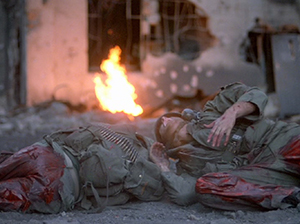 498 |
 499 |
 500 |
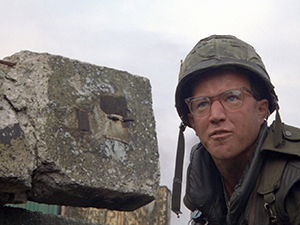 501 |
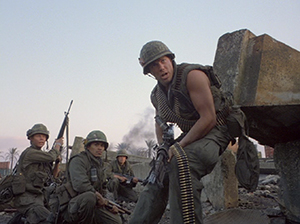 502 |
 503 |
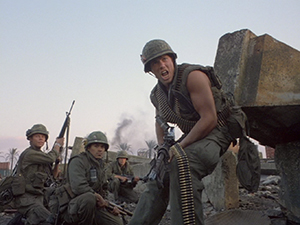 504 |
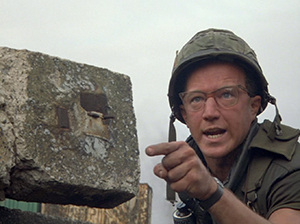 505 |
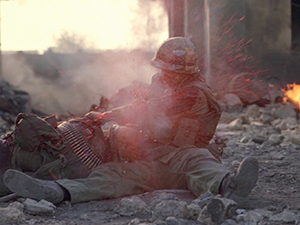 506 |
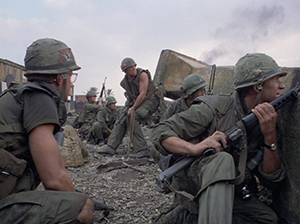 507 |
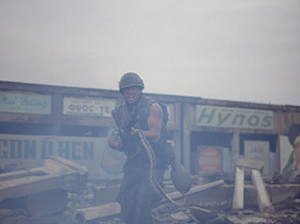 508 |
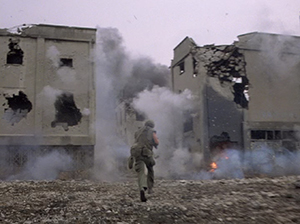 509 |
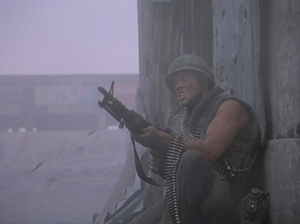 510 |
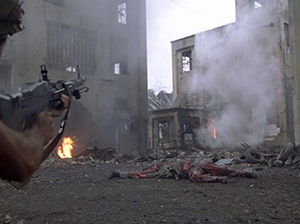 511 |
 512 |
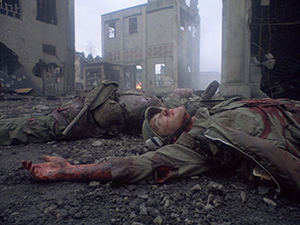 513 |
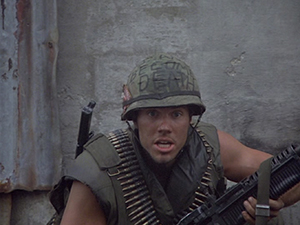 514 |
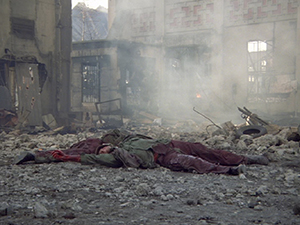 515 |
 516 |
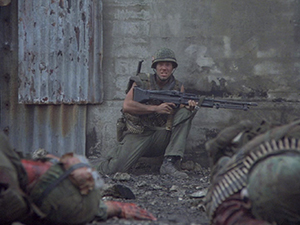 517 |
|
518 LS from Animal Mother's right of the My-Toan building, he looking at it from around the corner of the building that is shielding him. A sniper bullet hits near him and he backs away from the corner. (1:38:02)
ANIMAL MOTHER: Fuck.
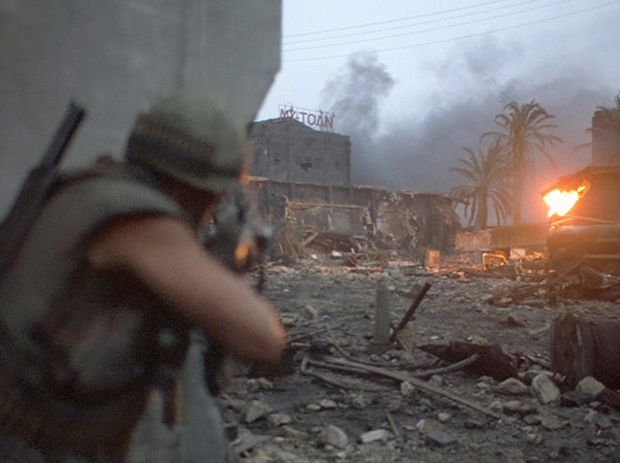
519 LS of Animal Mother from the rear. He races across to the blue doors of the opposite building to look inside it. (1:38:12)
520 From behind Joker and Cowboy, looking across the open area at Animal Mother standing in the blasted out blue facade of the building. (1:38:42)
ANIMAL MOTHER: Hey, Cowboy.
COWBOY: Yeah?
ANIMAL MOTHER: Doc Jay and Eightball are wasted. There's only one sniper, nothing else.
521 View from Cowboy's right of Cowboy and Joker and others. (1:38:54)
ANIMAL MOTHER (off screen):
Move up the squad, you're clear up to here. Come on.
All look at Cowboy.
COWBOY (putting back on his glasses which he'd removed): Son of a bitch. Okay, listen up.
T.H.E. ROCK: Listen up.
522 CU of Cowboy. (1:39:14)
COWBOY: No-Doze, Stutten, Donlon, Rock, you come with me, we'll take a look.
523 View from Cowboy's right of Cowboy and Joker and others. (1:39:19)
COWBOY: The rest of you all stay put and cover our ass. We may be coming back in a big hurry.
JOKER: I'm going with you.
RAFTER MAN: I'm coming too.
COWBOY:
Okay. You all set?
The Marines voice they are.
COWBOY: Let's move out.
524 LS from the rear of the Marines. (1:39:36)
MARINE: Let's do it.
They climb over the wall and begin to run across the open area.
525 LS View from the right of the Marines running toward the building where Animal Mother ha taken cover. He leads them around to the rear of it and across to a neighboring building where they take cover. (1:39:45)
526 Animal Mother, Cowboy, Joker, Rafter Man and others crouched down. (1:40:06)
527 Shot from rear as they cross the street to another building and take cover. (1:40:11)
ANIMAL MOTHER: Hey, Cowboy. Top of the black building, around the corner.
Animal Mother and Cowboy change places.
528 CU from behind Cowboy as he looks around the corner at the MY TOAN building. (1:40:30)
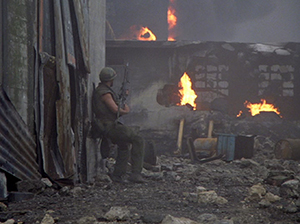 519 |
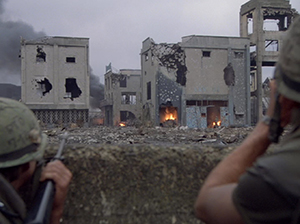 520 |
 521 |
 522 |
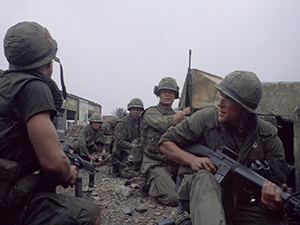 523 |
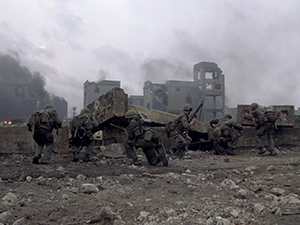 524 |
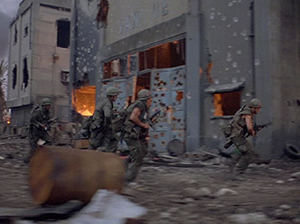 525 |
 526 |
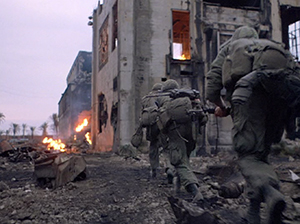 527 |
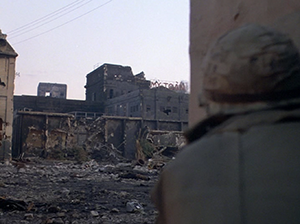 528 |
529 MS of the Marines lined up so we see the My TOAN building through a hole in the wall. (1:40:33)
COWBOY: Donlon, give me that radio. Murphy, this is Cowboy. Over.
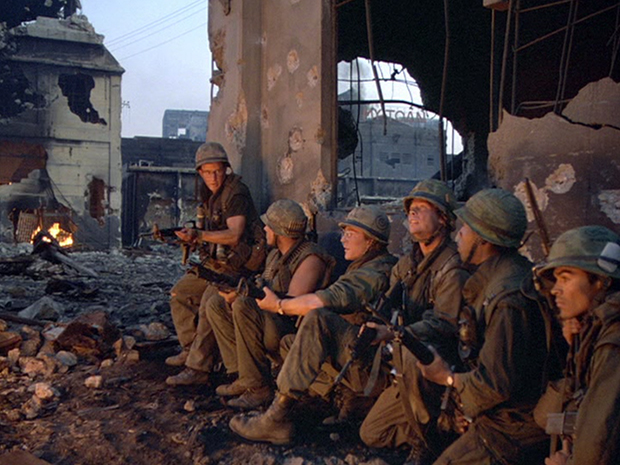
530 POV of Sniper gazing down at a window through which, in the hole in the wall, Donlon and Cowboy can be seen. Zoom in. Shot. (1:40:50)
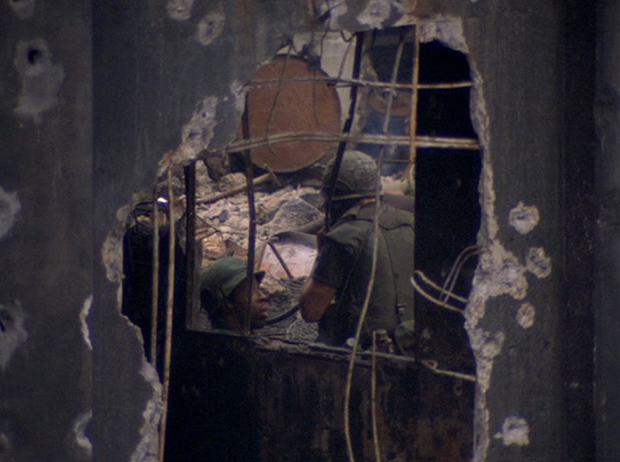
531 MCU of Cowboy, the MY-TOAN building viewed in the distance, as the bullet hits him. Slow motion. Quick zoom in on the sniper's window. (1:40:54)
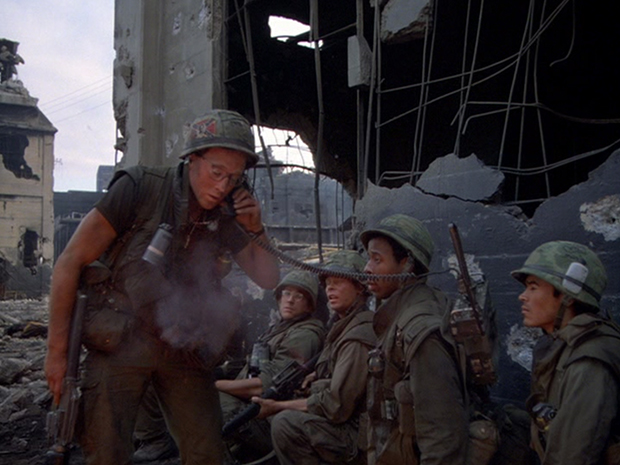
532 MLS of Cowboy as he falls. (1:41:01)
JOKER: Cowboy.
RAFTER MAN: Holy shit! That sniper's got a clean shot.
MARINE: Get him the fuck out of here.
The Marines drag Cowboy behind the building as Animal Mother fires on the MY-TOAN building.
MARINE: I ain't got any first aid.
COWBOY: I don't believe this shit.
MARINE: Give me a hand.
MARINE: Shut up.
533 MS of Cowboy held by Joker, surrounded by T.H.E. Rock, Donlon and Rafter Man. (1:41:20)
JOKER: Take it easy. Don't move.
COWBOY: Shit. Ah, son of a bitch.
JOKER: You'll be all right.
MARINE: You're going home.
JOKER (to Cowboy): Shut up!
COWBOY: Don't shit me.
JOKER:
You know I'm not gonna shit you, man. You're my favorite turd. Cowboy.
DONLON: Hang on, man. Hang on.
COWBOY:
I can hack it. I can hack it.
T.H.E. ROCK: You can hack it.
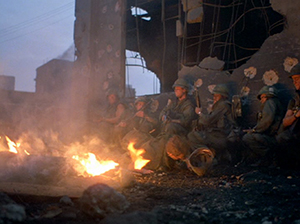 532 |
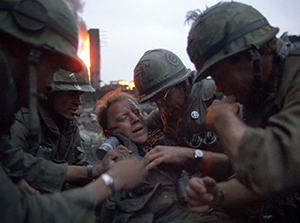 533 |
534 MS from behind Animal Mother and others firing on the MY TOAN building blasting its sign. (1:41:49)
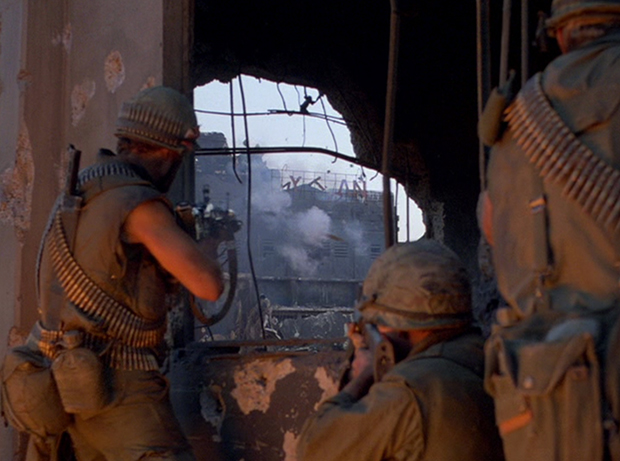
535 Cowboy held by Joker as in shot 533. (1:41:51)
COWBOY (spitting up): I can hack it.
T.H.E. ROCK: You can hack it.
Cowboy dies with his eyes open. Joker embraces him.
536 LS of the Marines with Cowboy, Joker bent over him, a lone wall of a building burning beyond. After a moment, they rise. (1:42:25)
537 MLS of Animal Mother going to them and finding Cowboy has died, (1:42:42)
538 MCU Animal Mother. (1:42:52)
ANIMAL MOTHER: Let's go get some payback.
539 MCU Joker. (1:42:57)
JOKER: Okay.
540 The Joker and others begin to back around the building. (1:43:05)
ANIMAL MOTHER (checking around the rear corner of the building):
Okay.
Animal Mother runs down the street with Joker following, then Rafter Man.
ANIMAL MOTHER (pointing to a hole in the building through which the MY-TOAN sign is seen still intact): Watch that fucking hole. (To Joker.) Throw some smoke.
541 The line of men along the wall of the building. Animal Mother throws a smoke bomb. (1:43:27)
542 Low from behind Joker and Animal Mother as Joker throws a smoke bomb. The area beyond fills with smoke. (1:43:31)
543 The line of men along the wall of the building. (1:43:39)
544 Low from behind Joker and Animal Mother. (1:43:41)
ANIMAL MOTHER:
Okay, ready?
They run through the smoke to the MY-TOAN building, going around to the rear.
545 MS of Joker. Begin music. (1:44:01)
At 1:44:06 the camera passes behind a portion of wall that momentarily blacks out the screen.
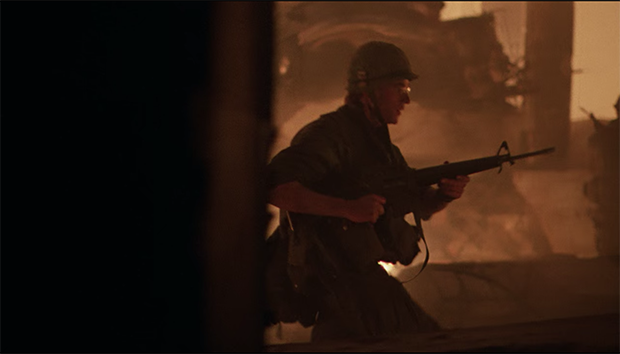
546 Long shot of the Marines. (1:44:11)
ANIMAL MOTHER: Donlon, Rock, that way. (He points left. Then address Joker and Rafter Man, going screen right) You two, with me. (They round a wall and he points left into a doorway.)
Joker, in there. New guy...
Joker enters through the larger door to the left and Rafter Man follows Animal Mother through another door.
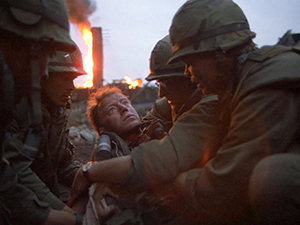 535 |
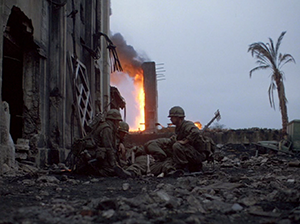 536 |
 537 |
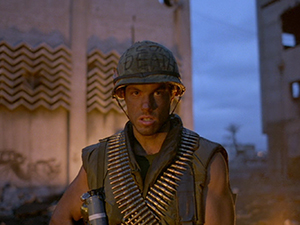 538 |
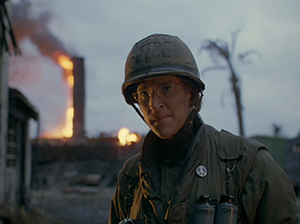 539 |
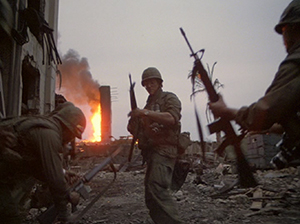 540 |
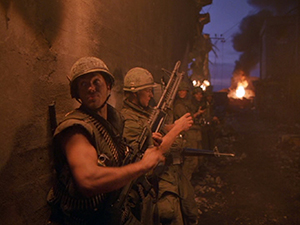 541 |
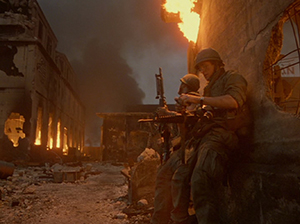 542 |
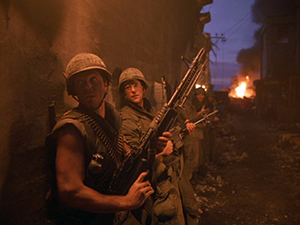 543 |
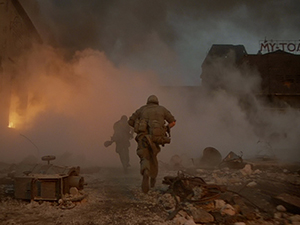 544 |
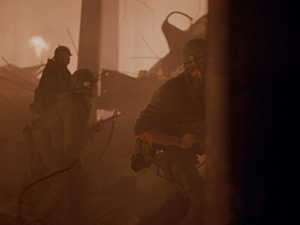 545 |
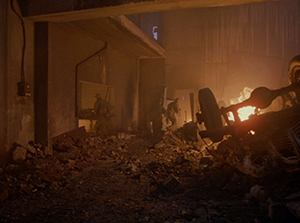 546 |
Eightball comes to the conclusion that they have taken a wrong direction and need to change course. Doing so, Eightball is killed by the sniper, Doc Jay is killed when he attempts to rescue him, and Cowboy is killed when they pursue the sniper.
I've watched a number of interviews with Marine veterans of Vietnam, and in one interview a veteran described how, as the Marines left no one behind, a sniper would injure someone, trusting others would come to their aid, the sole purpose being to reduce combatants.
What to do, logically, is to abandon the injured individual in order to save others. But bonding and training, the hope of trying to render aid as long as someone's alive, means having to decide between logic and the impulse to rescue, to not leave anyone behind even if it means sacrificing other lives. In 2001 we had much the same scenario when Dave Bowman goes out to rescue the body of Frank Poole. We are well aware that Poole will be dead, but there is at first the hope that he might have survived. When that hope can't be sustained, the rescue of his body still feels important, because we want confirmation and it's vitally important to Bowman that his friend and colleague not be left to drift in space but returned home. Bowman's desperate rescue of Poole's body provides the opportunity for HAL to murder Bowman by not letting him back into the ship. Bowman, in order to save his own life, must release to space the body of Poole, and it is a deeply affecting moment.
In the novel, in the first sniper incident, T.H.E. Rock, who is never harmed in the film, is shot and the sniper picks off those who come to rescue him. Cowboy describes the incident to Joker, who had been unconscious with a concussion, relating to him how the squad commander, Lieutenant Shortround (who becomes Touchdown in the film) wouldn't permit his squad to try to rescue T.H.E. Rock as he knew what would happen. They looked on as another squad that went in was slaughtered. Animal Mother and Shortround had gotten into a fight over it, Animal Mother insisting on going in, and Shortround punched him in the face to keep him in line. Shortround and Animal Mother had already had a fight over Animal Mother's trying to rape young girls. Afterward, Shortround was killed by a frag, Animal Mother the only witness, and Cowboy's not all that certain that Animal Mother didn't do it. Cowboy, now in charge of the squad, seeks advice from Joker on whether to go in and try to get the sniper, not wanting to get anyone killed, but still desiring payback for T.H.E. Rock. Joker says he can't help with that decision, that he doesn't have the balls, which Cowboy takes as an affirmative that he should get squared away and go after the sniper. With the help of a tank (recommended by Joker), they search for the sniper, and when they find the individual it is a young woman. Joker had fallen and looked up helpless as she accidentally stepped on his chest, unaware he was there. As in the film, Rafter Man shoots the girl, saving Joker, but it is Joker who kills her rather than leaving her to suffer. This happened in the end days of the Battle of Hue within The Citadel.
In the second sniper incident, in the jungle of Khe Sanh, Cowboy is warned by Alice (Eightball in the film) that he feels something isn't right. He has heard something, or believes he has. Is it perhaps just a bird or something else? Cowboy insists that there aren't any AVN in the vicinity and they have to keep on moving. Alice, who is serving as point man, steps into a clearing and is shot. Cowboy tells everyone to move out, but Doc Jay goes in to help Alice and is cut down. A New Guy is cut down as well. Animal Mother insists that Marines don't leave anyone behind, so Cowboy gives Joker the responsibility of getting everyone safely back to the hill, warning him to make Animal Mother walk point, to never turn his back on Animal Mother, who fragged Shortround. Then Cowboy lobs in a smoke grenade and runs into the clearing. He's shot. Keeping himself conscious, he kills Doc Jay, the New Guy, and Alice. Then it's Joker's turn. In order to keep the squad from pursuing its tradition of suicide, he shoots Joker.
The book thus gives the reader situations that are more complex than the film. Kubrick doesn't present the audience with the problem of Animal Mother raping girls. He doesn't present the audience the problem of Animal Mother killing the squad commander. He hones it down to the problem of Marines committing suicide by tradition in their efforts to save fellow Marines. Animal Mother becomes almost a hero, due his bravado, but he is a problem. He is against Cowboy from the beginning, not following his commands. One doesn't want to waste ammo, but Animal Mother insists on madly firing his gun, with no clear target, despite Cowboy demanding he not, and not once in the film do we have any evidence that Animal Mother accomplishes anything other than causing strife. The snipers at the Leyna building were apparently stopped by T.H.E. Rock's mortar. Crazy Earl was the one who made two confirmed kills when he saw the NVA pulling out. Animal Mother, in this scene, certain there is only one sniper, goes against Cowboy's orders and runs to the protective cover of a building near Doc Jay and Eightball in order to learn from them where the sniper is located. Though Animal Mother is right, there will turn out to be only one sniper, the consequential pursuit of the sniper results in Cowboy being killed when he thoughtlessly rises from a crouch and stands with his back to a hole in the building and is shot through that hole. Animal mother leads Joker in to get payback, but Joker is nearly killed and only saved by Rafter Man. Then Joker is the one who must kill the girl, knowing she won't survive. Still, despite the fact Animal Mother only causes problems and wastes a lot of ammunition, because he leads Joker into a situation where he finds the sniper and Rafter Man shoots her, Animal Mother is sometimes read as heroic, due his relentless firing at no visible target.
Kubrick, translating books into films, has a habit of softening up characters in order to make easier to digest films that remain difficult.
In A Clockwork Orange, Alex was a more troubled character in the novel, his crimes including the rape of two preteen girls. Kubrick preserved the rape of Alexander's wife, and much of the other brutality, but he would have wanted the audience to be able to sympathize with Alex when he was released from the hospital a changed man due to the Ludovico treatment. The rape of Alexander's wife may have been horrible, but the rape of two preteen girls would have put Alex beyond any kind of sympathy in the eyes of the audience--plus it was a movie that was going to have a difficult enough time with the censors already, and Kubrick probably wasn't interested in presenting all Alex's crimes to the audience, because the film was less about what Alex did than the problem of fate versus free will. It became radical enough for Alex to have a consensual threesome.
Kubrick made Barry Lyndon a more attractive character than in the book so that the audience could more easily comprehend how he had been affected by his experiences as a youth, both with Nora and in the military.
Red Alert, a heart-rending and tragic novel, was made into the comedic Dr. Strangelove, and though far different from the book it very well got the book's main point across.
A character he didn't ease up on was Jack in The Shining, who he remained interested in pursuing right into Full Metal Jacket, so that when Pyle breaks he takes on the mannerisms of Jack.
Kubrick was simply not interested in a film that presented to the audience all the horrors of Vietnam that Gustav laid out in The Short-timers. He wanted to make a film about combat, hoping to translate for the audience what it is like, which is going to be almost impossible to do, but he succeeded enough that, though some veterans were more impressed with the boot camp section, many found it to be a film that portrayed their experience in Vietnam, to the extent that some might praise it but couldn't watch it a second time as it brought back too many memories.
The deaths of Eightball, Doc Jay, and Cowboy are all hard felt by the audience as these are characters with whom Kubrick has spent time and built up a measure of audience sympathy. Doc Jay is a rescuer. Eightball is a likable peace keeper. Cowboy is Joker's friend.
From the book, Cowboy decides to pursue the first sniper in Hue, after having questioned whether he should:
Cowboy looks at me, then at the squad. Cowboy pulls me aside. We walk ahead for a few steps. "That sniper opened up on us in a gook graveyard. Some guys in One-One told us they found gold bars in the Emperor's palace. They had all they could hump, so we was going to souvenir the rest." Cowboy wipes sweat from his eyes. "T.H.E. Rock was walking point. The sniper shot T.H.E. Rock's foot off. Shot it off. The Hardass Squad went out to get him, one at a time. That sniper shot all their feet off. We were hiding behind graves, those old round graves like baseball mounds, and we had nine grunts down in the street...." Cowboy pulls a red bandanna from his back pockets and wipes his sweaty face. "Mr. Shortround wouldn't let us go get them. It made him sick, but he held us back. Then the sniper started shooting off fingers, toes, ears--everything. The guys in the road were crying and begging and we were all growling like animals, but Mr. Shortround held us back. Then Animal Mother started to go for them and the Skipper grabbed Animal Mother's collar and hit him in the face. Animal Mother was so mad I thought he was going to kill us all. But before he could do anything the sniper started putting rounds into the guys in the street. He didn't miss more than a couple of times. He popped T.H.E. Rock's head off and then he put a round through each guy's head. They were all moaning and praying and then it was quiet and they were dead and it was like we were dead too..." I don't know what to say.
... "I just can't hack this shit, bro. My job is to get my people back to the World in one piece." Cowboy coughs, spits, wipes his nose with the back of his hand. "Under fire, these are the best human beings in the world. All they need is for somebody to throw hand grenades at them for the rest of their lives...These guys depend on me. I can't send my people out to get that sniper, Joker. I might lose the whole squad."
I wait until I'm sure that Cowboy has finished talking and then I say, "That sounds like a personal problem to me, Cowboy. I can't tell you what to do. If I was a human being instead of a Marine, maybe I'd know." I scratch my armpit. "You're the honcho. You're the sergeant around here and you give the orders. You make the decisions. I could never do it. I could never run a rifle squad. Never happen, bro. I just don't have the balls."
Cowboy thinks about it. Then he grins. "You're right, Joker. You shitbird. You're right. I've got to get my program squared away. I wish Gunny Gerheim was here. He'd know what to do." Cowboy thinks about it. He grins. "Shit." He walks back to the squad. "Moving..."
The squad hesitates. Crazy Earl has always been the one to say what is.
Animal Mother stands up. He sets his M-60 machine gun into his hip. He doesn't speak. He looks at the dirty faces of the squad. He moves out.
The squad collects its gear and gets to its feet.
Cowboy waves his hand and Mother takes the point.
From the book's second sniper incident in Khe Sanh, Alice, having taken point, hears something and is shot:
Silence.
"A bird," says Cowboy. "Or a branch falling. Or--"
Alice shakes his head. "Maybe. Maybe. Or maybe a rifle bolt going home."
Cowboy's voice is stern: "You're paranoid, Midnight. No gooks here. Not for maybe another four or five klicks. We got to keep moving or we'll give the gooks time to set up an ambush in front of us. You know that..."
Donlon crawls over to Cowboy, handset at his ear. "Hey, Lone Ranger, the old man wants a report on our position."
"Let's move, Midnight. I mean it."
Alice rolls his eyes. "Feets, get movin'." Alice takes one step forward, then hesitates. "I can remember when I've had more fun."
I say in my John Wayne voice: "Viet Nam is giving war a bad name."
Daddy D.A., who's walking tail-end Charlie, calls out: "HEY, MR. VIET NAM WAR, WE HOMESTEADING?"
Cowboy says, "Everybody shut the fuck up."
Alice shrugs, mumbles, takes another step forward. "Cowboy, m'man, maybe old soldiers never die, but young ones do. It ain't easy being the black Errol Flynn, you know. I mean, if I don't get the Congressional Medal of Honor for all the crazy shit I do, I am going to send Mr. L.B.J. an eight-by-ten photo of my black bee-hind with a caption on the back, telling him what it is..."
Alice, the point man, moves out. He ditty-bops into a little clearing. "I mean--"
Bang.
The crack of an SKS sniper's carbine jolts Alice into a rigid position of attention. His mouth opens. He turns to speak to us. His eyes cry out.
Alice falls.
"HIT IT!"
Falling forward--now...
"Oh, no..." Black earth.
Dead leaves. "ALICE!"
"What...?" Damp. Bleeding elbows.
"MIDNIGHT!"
Looking, not seeing, looking...
"Oh-oh...Shit City..."
Waiting. Waiting. "Hey, man..."
Silence.
My guts melt.
"ALICE!"
Alice doesn't move and I curl up and try to make myself small and my asshole feels like it has been turned inside out and I think how wonderful it would be if Chaplain Charlie had taught me magic and then I could crawl up into my own asshole and just disappear and I think: I'm glad it's him and not me.
From the book, Doc Jay, attempting to help Alice, is shot:
"He hit Alice again!"
Alice moves, groans. "It hurts...it hurts..."
There's a dark hole through the canvas jungle boot on Alice's left foot. Alice laughs, grins, grits his teeth. "I'm short..."
Animal Mother kicks the rotten log and opens fire. High-velocity machine-gun bullets clip, chop, and ricochet through the canopy, snapping into tree trunks with rhythmic precision, cutting leaves from twigs and killing birds.
The New Guy opens up with his M-16. Lance Corporal Stutten fires an M-79 and the grenade bursts, invisible in the darkness. I see a strange shadow on a limb so I throw a few rounds in there with my grease gun. But it's Maggie's drawers. There's nothing to shoot at.
The New Guy pops a frag and lobs it in.
Cowboy screams into the jarring thud: "OKAY, OKAY, EVERYBODY FUCKING COOL IT."
Everyone stops firing--everyone except Animal Mother. I put my hand on Mother's shoulder but his weapon continues to spill hot brass and black metal links until the belt runs out.
"We gotta kill that cocksucker!" says Animal Mother. "Payback is a motherfucker!"
"Yeah."
"Yeah."
"The law of the jungle, man."
Animal Mother punches the rotten log with his fist. "I'll punch his fucking heart out!"
"Yeah."
"Kill that cocksucker!"
Alice is trying to crawl to cover. "Cowboy? Bro?" Alice extends his gloved right hand.
Bang.
Alice's hand is knocked down. He lifts it again slowly. Ragged leather. And Alice's right forefinger is missing. "Oh, no...not..."
Alice screams.
Doc Jay stands up. Cowboy grabs him and pulls him down. "You crazy?" But Doc Jay wrestles free. He unhooks the Unit One medical kit from his web belt and drops the rest of his gear.
Cowboy looks sick. "Don't try it, bro. That sniper does not miss..."
"I'm the corpsman," says Doc Jay." Not you." And before Cowboy can react, Doc Jay is on his feet and running. He runs at a crouch, zigzagging.
Bang.
Doc Jay stumbles, falls.
The Doc's left thigh has been torn open. Jagged bone protrudes. The Doc tries to push himself forward with his good leg.
Cowboy pops a smoke grenade, lobs it in.
"We've got to do something...."
The squad bunches up behind the boulder. "Spread out," I say, halfheartedly. The New Guy is watching with wild eyes, his weapon at port arms. Animal Mother's bloodshot eyes scan the canopy for muzzle flashes, movement, any sign of life. Lance Corporal Stutten and the rest of the squad watch silently--they are waiting for orders. Donlon is hugging his dead radio.
Doc Jay stands up, balances himself on his good leg. He bends over and hooks Alice under the armpit with his forearm, tries to lift him.
Bang.
Doc Jay collapses. Now his left foot is a bloody lump. He waits for the last bullet. When the last bullet doesn't come he sits up, pulls Alice across his lap. The Doc fumbles in his Unit One, takes out a Syrette, gives Alice a hit of morphine.
Using his teeth, Doc Jay tears the waxy brown wrappers off three compress bandages. The Doc ties the bandages around Alice's wound. Alice groans, says something we can't hear. Doc Jay uses his shirttail to wipe the sweat from Alice's forehead, then pulls out a piece of rubber tubing he uses to tie tourniquets.
Bang.
Doc Jay's right hand is shattered. The Doc tries to move his fingers.
He can't.
Green smoke pours from Cowboy's smoke grenade, obscuring the clearing.
Cowboy starts to tell us what to do. But he can't make up his mind. Then: "We're pulling out. That's a shitty thing to do, but we can't refuse to accept the situation. We saw this in Hue. That sniper is just sucking us in. Wants the whole squad, one at a time. You know that. Doc and Midnight are wasted; we're not. Saddle up."
Nobody moves.
Cowboy stands up. "Do it."
We all know that Cowboy is right. He's hard, but he's right.
"GET SOME!"
Without warning, the New Guy charges for the clearing. He fires blind. He lopes along with the fluid grace of a meat eater, a predator attacking. His chin is dripping saliva. The New Guy wants warm blood to drink. The New Guy wants human flesh to tear apart and devour. The New Guy's eyes are red: the New Guy's eyes glow in the shadow world around us. He fires blind. The New Guy doesn't know what the hell he's doing. He thinks he's John Wayne. He hasn't been born yet.
Cowboy tries to trip the New Guy as he double-times up the trail, but the New Guy catches his balance and runs faster, a werewolf charging into the house of death. He stumbles up to Doc Jay. He spins around. His red eyes probe the canopy. "Com'on, Doc. I'll help you. I'll carry--"
Bang.
For a breath or two we think maybe the sniper has missed for the first time. Then the New Guy drops to his knees, praying, clutching his throat.
Cowboy says, "Let's move."
"Move, my ass," says Animal Mother. "You move, motherfucker."
Cowboy takes a step toward Animal Mother, puts his face up close to Animal Mother's face, looks Animal Mother right in the eye. "Mother, take the point."
Animal Mother stands up, pulls his machine gun off the log and sets the butt into his hip so that the black barrel slants up at a forty-five degree angle. "Marines never abandon their dead or wounded, Mr. Squad Leader, sir."
Cowboy glares at Animal Mother for several deep breaths, then pulls me aside. "Joker, you're in charge. Move these people out," Cowboy sees that Animal Mother is listening so he adds, "Order Mother to walk the point."
Animal Mother spits.
Cowboy says in a low voice: "Never turn your back on Mother. Never cut him any slack. He fragged Mr. Shortround."
I say, "What about you, Cowboy? I mean, if you get yourself wasted who will introduce me to your sister?"
Cowboy looks at me. His face is without expression. "I don't have a sister. I thought you knew that." Cowboy looks at Doc and Alice and the New Guy. "Mother's right. I've got to try. The sniper will see you pulling back and--"
"Hey, never happen. Fuck it. You can't do anything."
"Move them out, Joker. By the numbers."
"But Cowboy, I--"
"It's my job," Cowboy says. "It's my job...." Cowboy says, as though his guts are choking him. Then: "Okay?"
I hesitate.
"Okay, bro?"
"Sure, Cowboy. I'll get them all back to the hill in one piece. I promise."
Cowboy relaxes. "Thanks, Joker." He grins. "You piece of shit."
Donlon yells: "LOOK!"
Doc Jay has the New Guy across his lap. The New Guy's face is purple. Doc Jay is kissing the New Guy's purple lips in an attempt to breathe life back into the limp body. The New Guy squirms, claws for air. Doc Jay holds the New Guy down, zips out his K-bar, cuts the New Guy's throat. Air whistles in through the crude incision, blows pink bubbles in the New Guy's blood. The New Guy bucks, wheezes, coughs. Doc Jay spills his Unit One, paws through splints, compress bandages, white tape. Then, frantic, he empties his pockets. The Doc throws everything away until he finds a ball-point pen. He stares at the ball-point pen, draws his hand back to throw the pen away, stops, looks again, unscrews the pen, inserts the biggest piece into the hole in the New Guy's throat. The New Guy sucks in air, breathes irregularly through the small plastic tube. Doc Jay puts the New Guy down on the deck, gently.
Bang.
Doc Jay's right ear is split. Cautiously, the Doc touches the side of his head, feels wet, jagged meat.
Bang.
A bullet cuts off Doc Jay's nose.
Bang.
A bullet passes through Doc Jay's cheeks. He coughs, spits up uprooted teeth and pieces of his gums.
Animal Mother snarls, fires his machine gun into the canopy.
"Get them back," Cowboy says. He drops his Stetson and Mr. Shortround's shotgun. He pops another smoke grenade, lobs it in. He jerks Mr. Shortround's pistol from his shoulder holster. And before I can tell Cowboy that a pistol is useless in the jungle he punches me on the shoulder like a kid and runs, feinting as wildly as the narrow trail allows.
We wait.
I know that I should be getting the squad on its feet, but I too am hypnotized.
From nowhere and from everywhere comes the sound of something laughing. We all rubberneck to see who aming us is so stone-cold hard that he is enjoying a world of shit like this.
The sniper is laughing at us.
We try to pinpoint the sniper's position. But the source of the laughter is all around us. The laughter seems to radiate from the jungle floor, from the jade trees, from the monster plants, from within our own bodies.
As the dark laughter draws the blood from my veins I see something. My eyes try to focus on a shadow. Sweat stings my eyes, blurs my vision. And I see Sorry Charlie, a black skull, perched on a branch, and then I understand that only a sniper that does not fear death would reveal his position by laughing....
I squint. I strain my eyes. The laughing skull fades into a shadow.
From the book, Cowboy has instructed Joker to take charge while he goes to Alice, the New Guy, and Doc Jay:
Today I am a sergeant of Marines.
I laugh and laugh. The squad freezes with fear because the sniper is laughing with me. The sniper and I are laughing together and we know that sooner or later the squad will be laughing, too. Sooner or later the squad will surrender to the black design of the jungle. We live by the law of the jungle, which is that more Marines go in than come out. There it is. Nobody asks us why we're smiling because nobody wants to know. The ugly that civilians choose to see in war focuses on spilled guts. To see human beings clearly, that is ugly. To carry death in your smile, that is ugly. War is ugly because the truth can be ugly and war is very sincere. Ugly is the face of Victor Charlie, the shapeless black face of death touching each of your brothers with the clean stroke of justice.
Those of us who survive to be short-timers will fly the Freedom Bird back to hometown America. But home won't be there anymore and we won't be there either. Upon each of our brains the war has lodged itself, a black crab feeding.
The jungle is quiet now. The sniper has stopped laughing.
The squad is silent, waiting for orders. Soon they will understand. Soon they won't be afraid. The dark side will surface and they'll be like me; they'll be Marines.
Once a Marine, always a Marine.
From the book, Cowboy kills Doc Jay, Alice and the New Guy. Having been himself injured, which he expected, he attempts to kill himself but the sniper makes this impossible, injuring his shooting hand. Joker kills Cowboy:
Cowboy stumbles into the clearing.
"We're moving," I say, more to Mother than anyone.
Mother ignores me, watches Cowboy.
Bang. Right leg.
Bang. Left leg. Cowboy falls.
Bang. The bullet rips open Cowboy's trousers at the crotch. "No...." Cowboy feels for his balls. He shits on himself.
Animal Mother takes a step.
Before I can make a move to stop Animal Mother a pistol pops in the clearing.
Bang.
Then: Bang.
Donlon: "HE KILLED DOC JAY AND THE NEW GUY!"
Cowboy shakes himself to stay conscious. Then he shoots Alice through the back of the head.
Bang. Alice's face is blown off by the forty-five caliber bullet. Alice flops as though electrocuted.
Cowboy raises the pistol and presses the huge barrel to his right temple.
Bang.
The pistol falls.
The sniper has put a bullet through the center of Cowboy's right hand.
The squad bunches up behind the boulder again. I study the dirty faces of all my bearded children: Animal Mother, Donlon, Lance Corporal Stutten, Berny, Harris, Rick Berg, Hand-Job, Thunder, The Kid from Brooklyn, Hardy, Liccardi, and Daddy D.A.
"Stutten, take your people back."
Lance Corporal Stutten looks at Animal Mother, takes a step toward him. The squad is going to follow Mother and commit suicide for a tradition.
Mother checks his M-60. His face is wet with tears, Viking-wild, red with rage. "We'll go for Cowboy, give the sniper too many targets. We can save him."
I take a step into Animal Mother's path.
Animal Mother raises his weapon. He holds the M-60 waist high. His eyes are red. He growls deep in his throat. "This ain't no Hollywood movie, Joker. Stand down or I will cut you in half..."
I look into Animal Mother's eyes. I look into the eyes of a killer. He means it. I know that he means it. I turn my back on him.
Animal Mother is going to waste me. The barrel of the M-60 probes my back.
The squad is silent, waiting for orders.
I raise my grease gun and I aim it at Cowboy's face. Cowboy looks pitiful and he's terrified. Cowboy is paralyzed by the shock that is setting in and by the helplessness. I hardly know him. I remember the first time I saw Cowboy, on Parris Island, laughing, beating his Stetson on his thigh.
I look at him. He looks at the grease gun. He calls out: "I NEVER LIKED YOU, JOKER. I NEVER THOUGHT YOU WERE FUNNY--"
Bang. I sight down the short metal tube and I watch my bullet enter Cowboy's left eye. My bullet passes through his eye socket, punches through fluid-filled sinus cavities, through membranes, nerves, arteries, muscle tissue, through the tiny blood vessels that feed three pounds of gray butter-soft high protein meat where brain cells arranged like jewels in a clock hold every thought and memory and dream of one adult male Homo sapiens.
My bullet exits through the occipital bone, knocks out hairy, brain-wet clods of jagged meat, then buries itself in the roots of a tree.
Silence. Animal Mother lowers his M-60.
Animal Mother, Donlon, Lance Corporal Stutten, Harris, and the other guys in the squad do not speak. Everyone relaxes, glad to be alive. Everyone hates my guts, but they know I'm right. I am their sergeant; they are my men. Cowboy was killed by sniper fire, they'll say, but they'll never see me again; I'll be invisible.
"Saddle up," I say, and the squad responds. Packs are hefted up. The flap and rattle of equipment. A grunt, a growl, and the Lusthog Squad is ready to move.
I study their faces. Then I say, "Man-oh-man, Cowboy looks like a bag of leftovers from a V.F.W. barbecue. Of course, I've got nothing against dead people. Why, some of my best friends are dead!"
Silence. They all look at me. I have never felt so alive.
Semper Fi, Mom and Dad, Semper Fi, my werewolf children. Payback is a motherfucker.
They shift their gear to more comfortable positions.
They wait for an order. I pick up Cowboy's muddy Stetson.
I wave my hand and the squad moves out, moves back down the trail.
Nobody talks. We're all too tired to talk, to joke, to call each other names. The day has been too hot, the hump too long. We've shot up our share of Victor Charlie jungle plants and we are wasted.
We wrap ourselves in pastel fantasies of varied designs and "X" another day off our short-timer's calendars. We look forward to imaginary bennies: hot showers, cold beer, a fix of Coke (because things go better with Coke), juicy steaks, mail from hone, and a moment of privacy in which to massage our wands, inspired by fading photographs of loving wives and girlfriends back in the World.
The showers will be cold, the beer, if there is any, will be hot. No steak. No Cokes. The mail, if there is any, will not be from sweethearts. The mail from hometown America, like the half dozen letters I carry unopened in my rucksack, will say: Write more often be careful if you think it's tough there bought this used car what a report card mother is taking shots nothing good on TV don't write depressing letters so maybe send me fifty bucks new furniture in the dining room for a ring quick buddy she's pregnant be real careful write more often and so on and so on until you feel like you just got a Dear John letter from the whole damned world.
Those may be long excerpts to read from the novel, but I think it's important to get a feel for Hasford's writing, and to know how his book was plotted. Joker having to kill Cowboy is critical. It busts him. He's been made nearly amoral at the opening of The Phantom Blooper, causing a crazed radio man to be killed because he no longer looks on him as human and decides to use him as bait. He's traumatized, crazed, demoralized. It's important that he kills Cowboy because at the end of The Phantom Blooper he makes the trip to see Cowboy's parents...who blame John Wayne for their son's death. And though Joker had mocked John Wayne throughout, there's still a link in which Joker became the intercessor. He had no real choice. It was a mercy killing for Cowboy and the troops, but he still was the one who shot him.
Joker becomes the Winter Soldier. Then he pivots and becomes the Phantom Blooper, the alarming and frightening prospect of the fellow Marine or soldier who crosses the line and takes up the opposing perspective, which is frightening because of the doubt it might raise as to the defensibility of one's own beliefs.
In The Shining, as Jack looks over the maze on the table top, we are given a sense of hubris, of his being omniscient as he stares down at the world maze in which he can see everything and the vulnerable Wendy and Danny. At least, with the quality of his gaze, we are given this impression, but as I've discussed we appear to be looking down from the perspective of the man who had examining the maze on the day of the interview.
We have already seen Jack, in a crossfade, looming gigantic over Wendy and Danny as they crossed to the maze. If we think about it, we have the same situation here. Kubrick has positioned the sniper so that no one knows at first where they are. Even when Animal Mother learns the direction they're in, we still don't know exactly where the sniper is. As with Jack and the elderly man looking upon the maze in the lobby of the hotel, the sniper has a similar quasi-omniscient position, looking down over the square as Eightball, then Doc Jay enter it, picking them off one by one.
One begins to have the feeling of a game board, and might look back to HAL in 2001, who defeats Frank at chess, then after pursuing a psychological game with Dave as to whether or not he has any questions about their mission, asserts that the AE-35 is going to fail and must be replaced. Mission Control states HAL is in error. HAL says those in error are human, and that it has always been this way, he is faultless--and what is faultlessness often equated with? Omniscience, and as long as HAL's "consciousness" is operative, it's easy enough for him, with his control over the ship, to clear its decks of the others. But Dave is still able to outmaneuver the computer.
Ultimately, though we assume that HAL's subsequent murder of Frank, and those in hibernation, and his attempt to kill Dave, exposes he is absolutely in error, going renegade, it's never explicitly resolved what happened. The audience is left in the position of guessing and debating. In Full Metal Jacket, as well, we never learn what kind of an error was made, if they had gone in the wrong direction, and a correction had placed them in danger, or if they err in believing they've gone in the wrong direction .
But what's important to me is the communication of the sense of omniscience over what comes to feel like a very bloody game board. This isn't to say that the sniper is placed in this position in Full Metal Jacket. At this point we are led to believe the individual is a man, for we've seen a man's hand, but this will change, and what the sniper means to the film will also change. Instead, the sense of omniscience is more removed, becoming as in the sense of omniscience possessed by the hotel in The Shining, so that Jack isn't the one with the power, he is instead only operating in service of what he believes has supreme power. He agrees to "discipline" Danny and Wendy because they are perceived as chaotic elements in that they work against the system. Danny's a danger because he comprehends better than Jack the patterns that constitute the hotel and is able to work around them by having learned how to hide himself in the maze. Wendy is a danger because of her love for Danny that places the preservation of her family above anything else. But it is also how she finds herself in a position of danger at the hotel in the first place.
Now I have to make my case for there being some intentional disorientation so that for a long while we are never sure where the sniper is situated, and are confused on the relationship of buildings to one another once we move into the interior of the complex, when on the exterior it looks like it should be fairly simple.
I'm not done with this section of the film. More in Part Seven.
Approx 17,000 words or 34 single-spaced pages.
Next: Full Metal Jacket Analysis - Part 7
Go to Table of Contents for Analysis of "Full Metal Jacket"
Link to the main TOC page for all the analyses